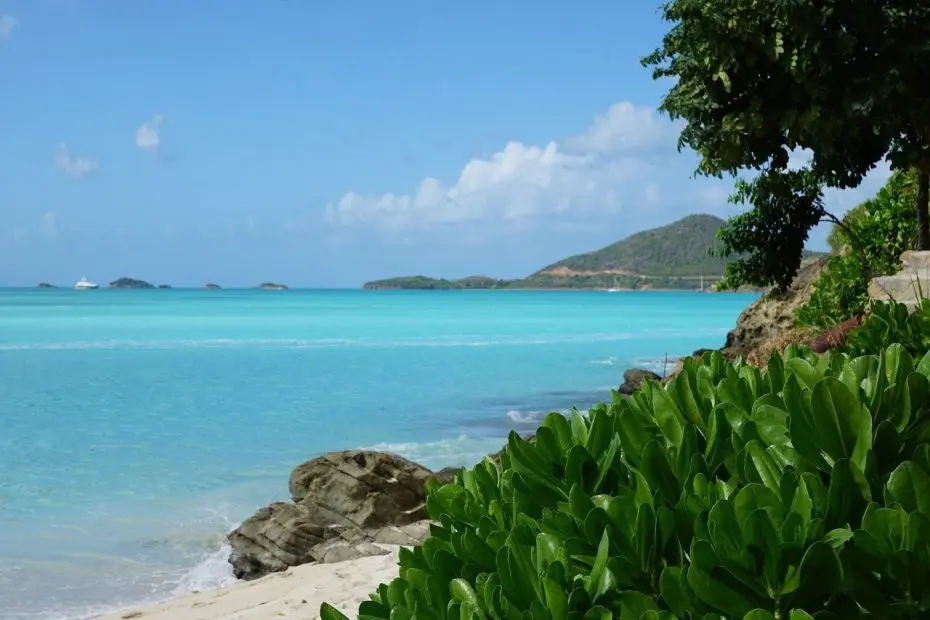Take Me to the Recipes
Antigua and Barbuda are two picturesque islands nestled in the Caribbean. They boast not only breathtaking scenery but also a rich culinary heritage.
Discover the vibrant flavors of Antigua and Barbuda’s national dishes, influenced by a rich history and a climate that defines the essence of Caribbean cuisine. From traditional recipes to the health implications of these flavorful delights, this article takes you on a culinary journey through the heart of the Caribbean.
From its sun-soaked beaches to its vibrant culture, Antigua and Barbuda offer a feast for the senses, with their delectable national dishes reflecting the diversity of influences that have shaped the region. In this article, we delve into the heart of Antiguan cuisine, exploring its history, climate, traditional recipes, and the health implications of its culinary delights.
Read on for a mouthwatering exploration of Antiguan cuisine!
Antigua and Barbuda Food – Key Takeaways
- Historical Fusion: Antiguan cuisine reflects a fusion of African, Amerindian, and European influences, creating a unique culinary tapestry.
- Climate’s Culinary Impact: The tropical climate influences the abundance of fresh ingredients, shaping the vibrant flavors of Antiguan dishes.
- Traditional Roots: Rooted in tradition, Antiguan recipes often showcase locally sourced ingredients and culinary techniques passed down through generations.
- Healthful Elements: Despite indulgent flavors, Antiguan cuisine emphasizes fresh, natural ingredients with potential health benefits.
- National Dish Pride: The national dish, pepper pot, symbolizes the country’s resilience and diverse heritage.
- Unique Ingredients: Explore the exotic flavors of local ingredients like breadfruit, saltfish, and the renowned Antiguan black pineapple.
- Culinary Tourism: Antigua and Barbuda’s cuisine offer a delicious invitation for culinary enthusiasts and tourists alike.
Take Me to the Recipes
Where is Antigua and Barbuda?

The tropical islands of Antigua and Barbuda are located in the heart of the Caribbean about a thousand miles to the east of Jamaica and half that distance from Trinidad on the coast of South America.

Index of Contents
- Take Me to the Recipes
- More Articles for Your Pleasure
- 10 Fascinating Facts about Antigua
- Antigua and Barbuda Food History and its Culinary Impact
- How Antigua and Barbuda Food’s Climate and Geography Influence the Cuisine
- Understanding the Essence of Antigua and Barbuda Food Recipes
- Traditional Antigua and Barbuda Food
- What are the Health Implications of Antigua and Barbuda Cuisine?
- Antigua and Barbuda Food’s National Dish
- Exploring Antigua and Barbuda Food Ingredients: The Flavors of Antigua and Barbuda Cuisine
- Antigua and Barbuda Recipes to Try at Home
- Conclusion
- Frequently Asked Questions
More Articles for Your Pleasure
- North and South American Cuisine – A Culinary Expedition
- European Cuisine: Savor the Continent’s Best Culinary Secrets!
- African Cuisine: Discover the Bold Flavors & Global Charm!
- Asian Cuisine Unlock its Secrets – Taste, Health & Global Influence!
- Oceania Cooking: A Culinary Journey Through the Pacific
Savor iconic Antigua and Barbuda Dishes – Click on each tantalizing picture to open up the Recipe.
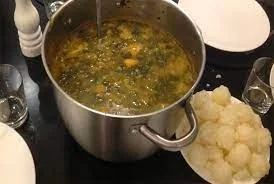
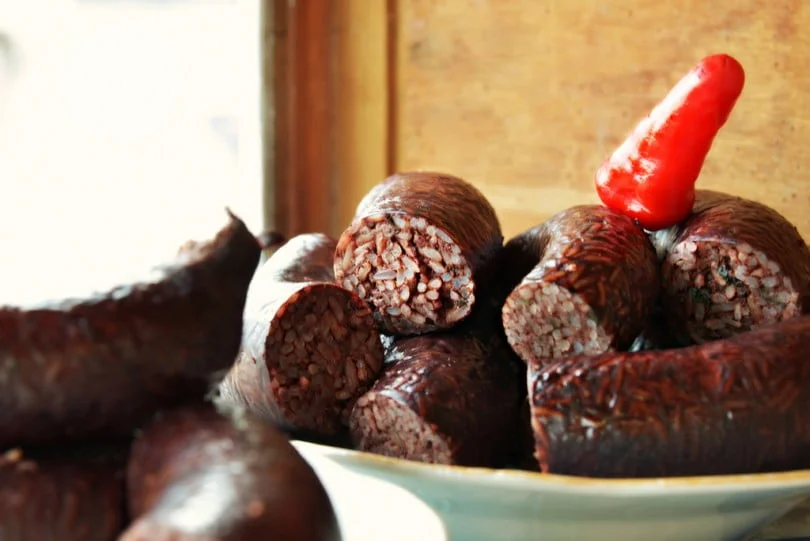
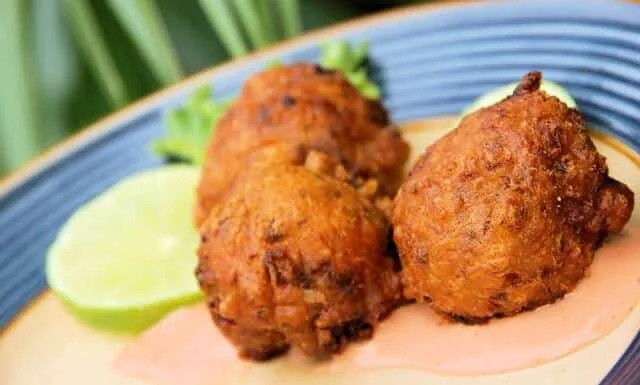
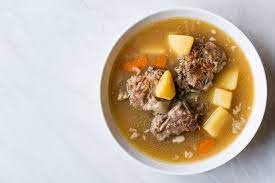
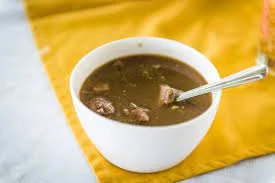
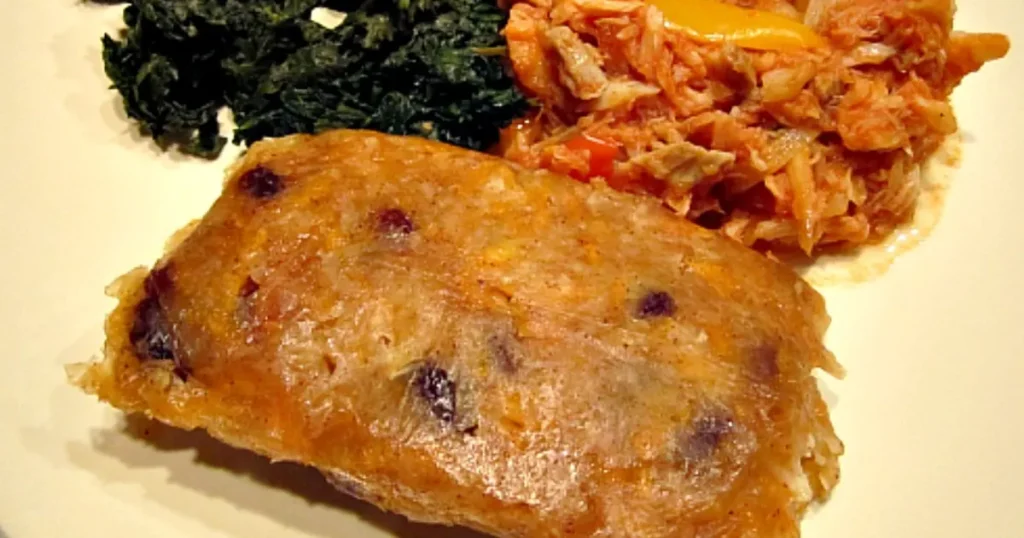
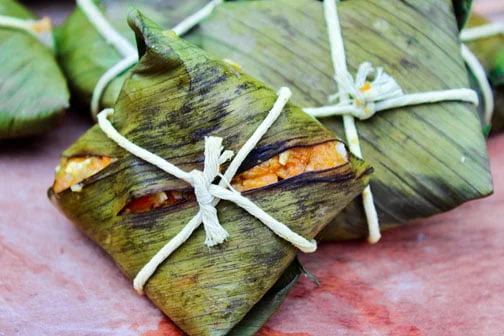
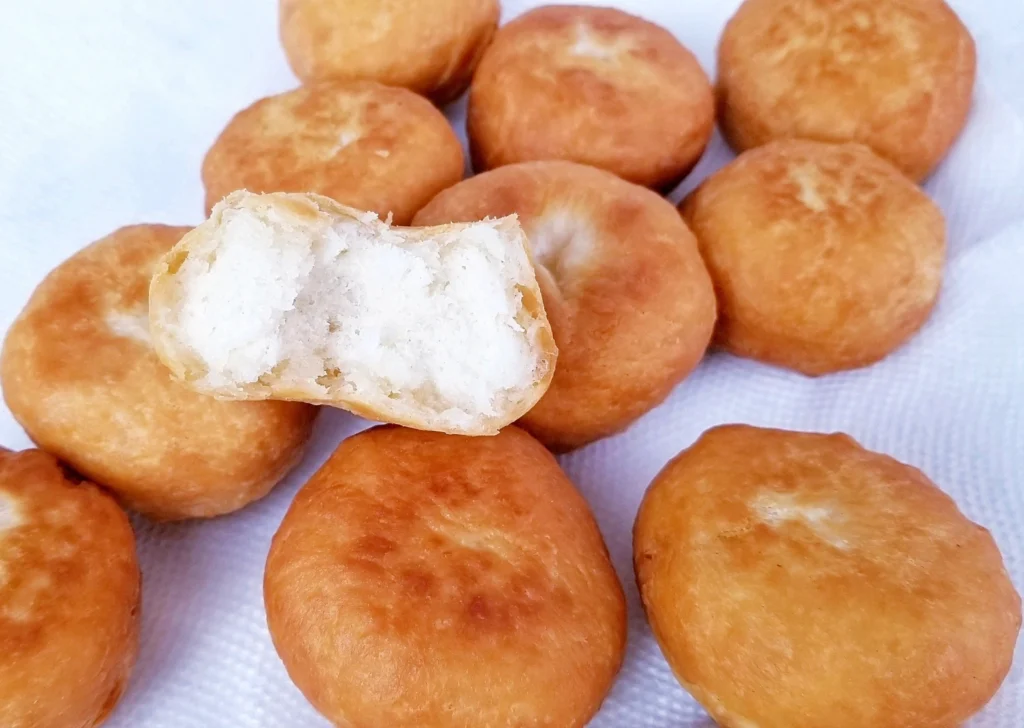
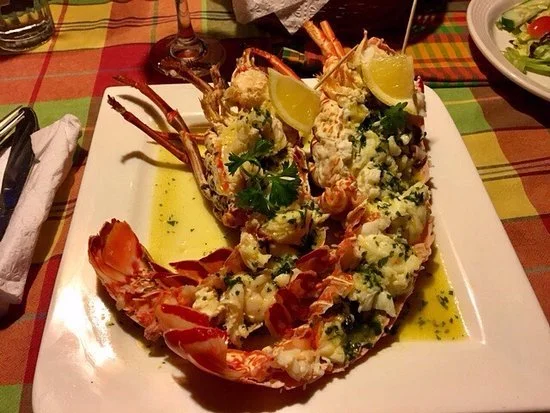
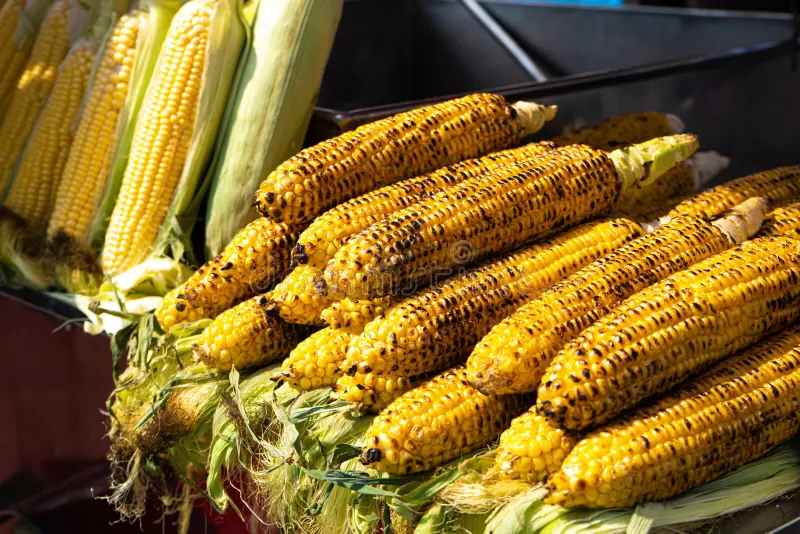
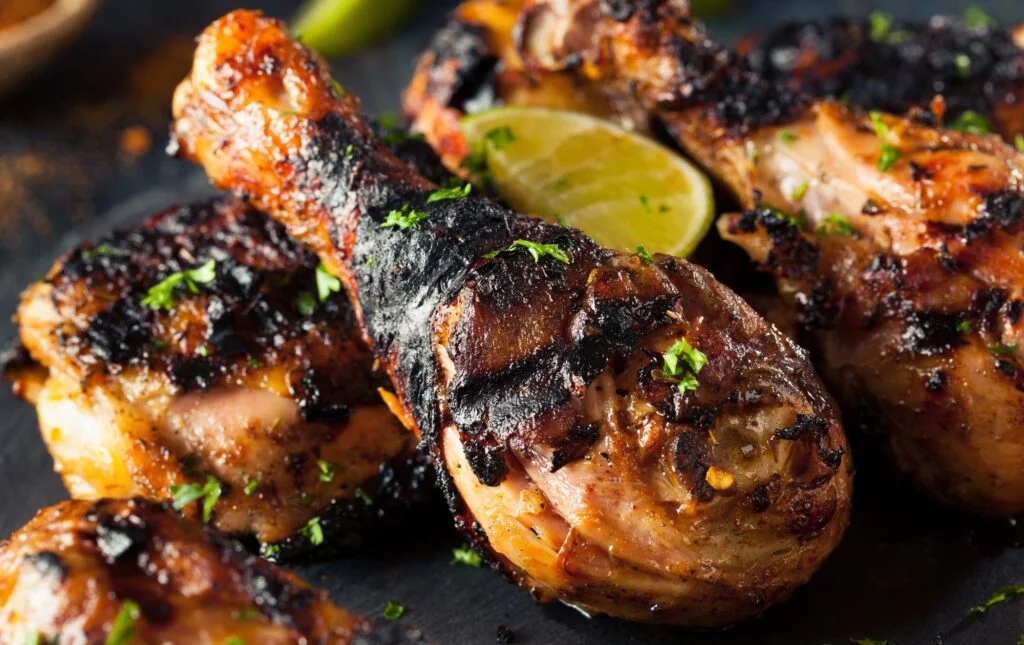
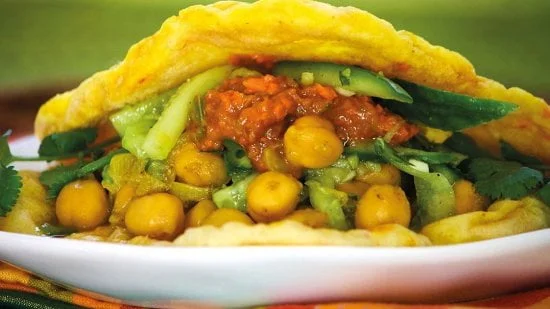
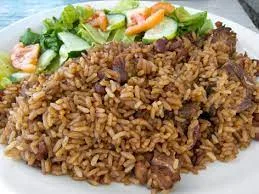
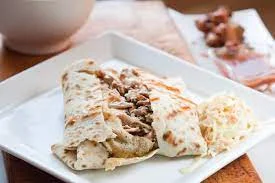
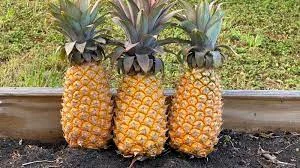
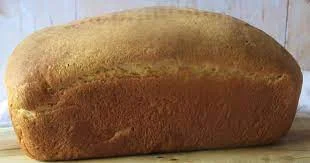
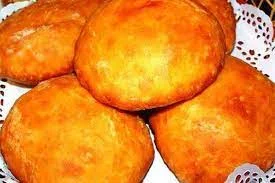
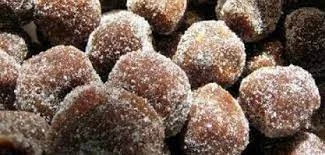
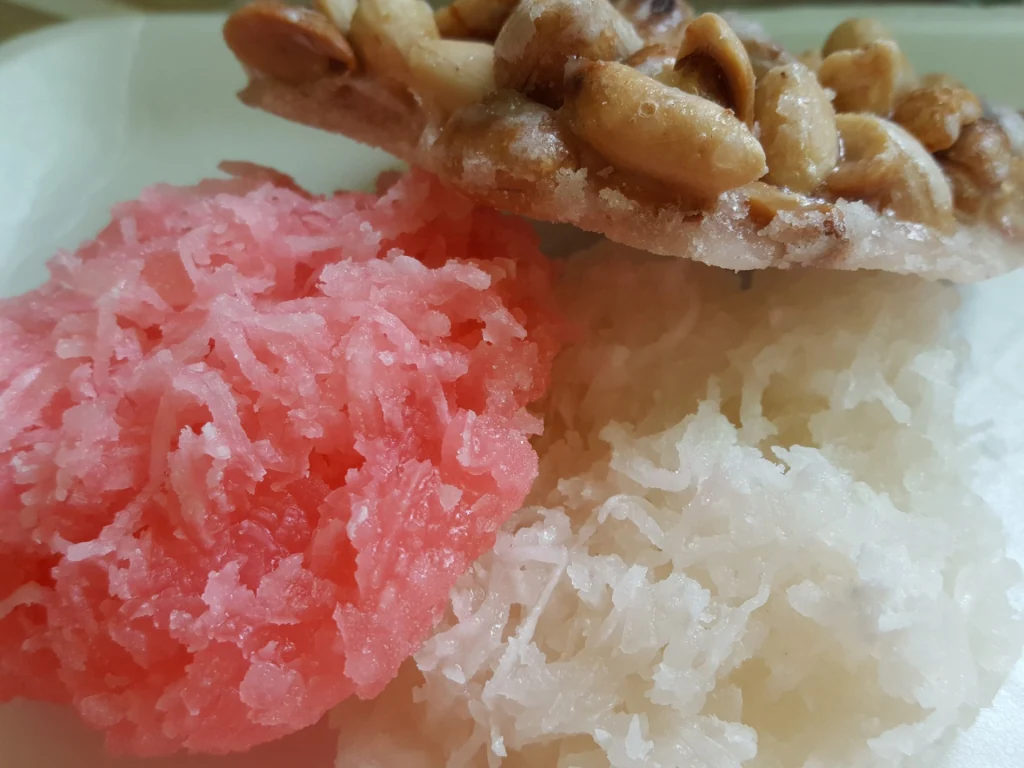
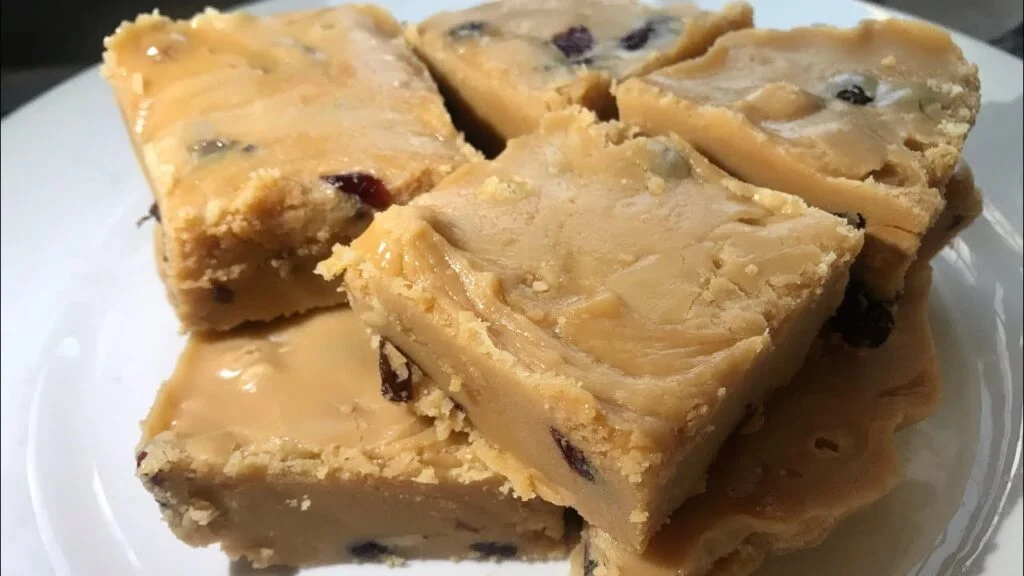
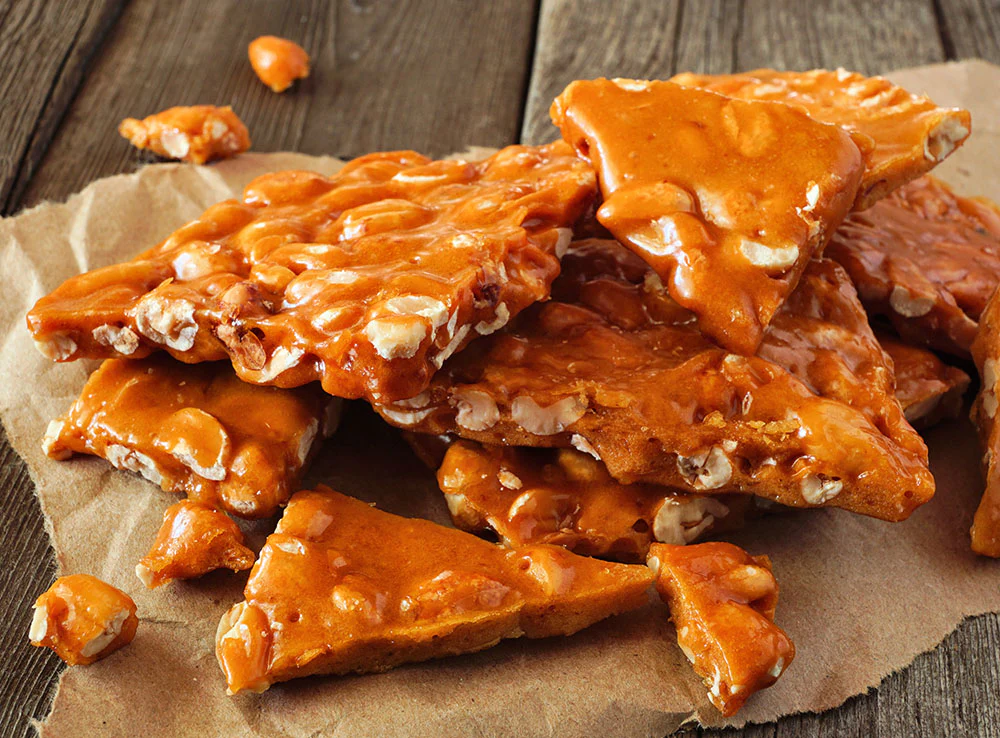
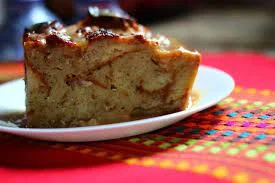
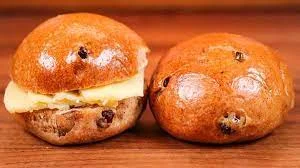
10 Fascinating Facts about Antigua

Join us as we explore 10 fascinating insights into the vibrant soul of Antigua, from quirky laws to intriguing facts that make this island paradise truly unforgettable.
Land of 365 Beaches
- Antigua boasts an astonishing 365 beaches—one for every day of the year. From pristine white sands to secluded coves and vibrant coral reefs, each beach offers its own slice of paradise, beckoning visitors to soak up the sun and savor the beauty of the Caribbean.
Donkey Sanctuary

- Antigua is home to the Antigua and Barbuda Humane Society Donkey Sanctuary, a haven for rescued and rehabilitated donkeys. Visitors can meet these gentle creatures, learn about their care, and even adopt a donkey to support the sanctuary’s important work.
Cricket is the National Sport
- Cricket holds a special place in the hearts of Antiguans, serving as the national sport of Antigua and Barbuda. The island boasts world-class cricket facilities, including the Sir Vivian Richards Stadium, named after the legendary West Indian cricketer.
Nelson’s Dockyard

- Nelson’s Dockyard, located in English Harbour, is the only continuously operating Georgian naval dockyard in the world. This UNESCO World Heritage Site offers a fascinating glimpse into Antigua’s maritime history and colonial heritage, with restored buildings, museums, and historic ships.
Stingray City
- Visitors to Antigua can experience the thrill of swimming with southern stingrays at Stingray City. These gentle giants inhabit the shallow waters of the Caribbean Sea, where guests can interact with them under the guidance of experienced guides.
Carnival Celebrations

- Antigua’s Carnival, known as the “Caribbean’s Greatest Summer Festival,” is a vibrant celebration of music, dance, and culture. Held annually in late July to early August, Carnival features colorful parades, calypso music, steel pan bands, and elaborate costumes.
The Pillars of Hercules
- Antigua is home to the Pillars of Hercules, two towering limestone formations located on the island’s rugged east coast. Legend has it that these natural landmarks were named by British sailors after the ancient Greek mythological hero.
Crab Racing

- Crab racing is a popular pastime in Antigua, where locals and visitors gather at beach bars to watch hermit crabs’ race along makeshift tracks. This quirky tradition is a lighthearted way to enjoy the island’s laid-back vibe and tropical ambiance.
Sailing Capital of the Caribbean

- Antigua is renowned as the sailing capital of the Caribbean, attracting sailors and yachting enthusiasts from around the world. The island hosts prestigious sailing events such as Antigua Sailing Week, where participants compete in exhilarating races amid stunning coastal scenery.
Respect for the Elderly

- Antiguan culture places a strong emphasis on respect for the elderly, with traditions such as “respect morning” where younger generations pay homage to their elders. This cultural value reflects the importance of family and community in Antiguan society.
Embrace the Charm of Antigua
From its pristine beaches to its vibrant culture and quirky traditions, Antigua captivates the imagination and leaves a lasting impression on all who visit. As we uncover the fascinating facts and quirks of this Caribbean paradise, let us embrace the charm of Antigua and celebrate its unique allure.
Antigua and Barbuda Food History and its Culinary Impact
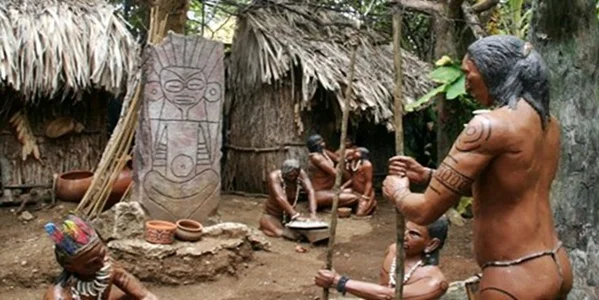
Antigua and Barbuda has a rich and diverse history, shaped by the interactions of various cultures and civilizations over the centuries.
The islands were first inhabited by the indigenous Arawaks and Caribs, who named them Wadadli and Wa’omoni, respectively. The Arawak’s were peaceful farmers and fishermen, while the Caribs were fierce warriors and raiders.
They both left traces of their art, language, and customs on the islands. The first European contact with the islands was made by Christopher Columbus in 1493, who named Antigua after a church in Seville, Spain.
However, the Spanish did not colonize the islands, and they remained largely ignored by the Europeans until the 17th century. The first permanent settlement was established by the English in 1632, who brought African slaves to work on the sugar plantations.
Antigua Became a British Colony

The islands became a valuable colony for the British Empire, and a strategic naval base for the Royal Navy. They also faced frequent attacks and invasions by the French, the Dutch, and other European powers, as well as rebellions and raids by the enslaved Africans and the free Maroons.
The islands were also affected by natural disasters, such as hurricanes, earthquakes, and droughts, which caused economic and social hardships. They remained under British rule until 1981, when they achieved independence as a constitutional monarchy within the Commonwealth of Nations.
One of the legacies of the British rule are the extensive sugar cane farms. Historically, most of the natural vegetation of Antigua and Barbuda was cleared for the cultivation of sugar cane and cotton. The economy is currently dominated by tourism, a sector that is also dependent on the quality of the environment.
Sugar is still cultivated, and other vegetable and fruit crops are grown on small farms, but Sea Island cotton is the only profitable export crop.
The cuisine of Antigua and Barbuda reflects the influences of each of the cultures and civilizations that have interacted with the islands over the centuries, such as the indigenous Arawak’s and Caribs, the European colonizers, the African slaves, and the Asian and Middle Eastern immigrants.
The Resultant Cuisine
Some of the main features of Antigua and Barbuda cuisine are:
- The use of local and fresh ingredients, such as seafood, fruits, vegetables, and herbs. Some of the most popular dishes include saltfish and chop up, bun and cheese, Johnny cakes, black pudding, and ducana.
- The incorporation of spices and flavors from different regions, such as rice, dates, saffron, cardamom, turmeric, cinnamon, and cloves. These spices add color and aroma to the dishes, and also help preserve the food in the hot and humid climate.
- The adaptation of dishes from other Caribbean countries, such as jerk meats from Jamaica, roti from Trinidad, and pepperpot from Guyana.
Antigua and Barbuda cuisine is a delicious and unique blend of ancient and modern, local and foreign, simple and sophisticated. It offers a variety of dishes that can appeal to any palate.
How Antigua and Barbuda Climate and Geography Influence the Cuisine

The islands are surrounded by the Atlantic Ocean and the Caribbean Sea, which provide a rich source of seafood and marine life.
The islands also have volcanic hills, coral reefs, mangroves, and sandy beaches, which create a variety of habitats and ecosystems. The climate and geography of Antigua and Barbuda have influenced the food and cuisine of the islands in several ways, such as:
Seafood
Seafood is a staple food in Antigua and Barbuda, as it is abundant, fresh, and nutritious. The islands have a wide range of fish and shellfish, such as grouper, snapper, lobster, conch, and crab.
Seafood is often fried, grilled, baked, or stewed, and seasoned with spices, herbs, and citrus. Some of the popular seafood dishes include saltfish and chop up, a dish of salted cod and vegetables; fungie and pepperpot, a dish of cornmeal dumplings and spicy meat stew; and ducana, a dish of sweet potato and coconut dumplings and fish.
Fruits and vegetables
Fruits and vegetables are also important in Antigua and Barbuda, as they provide vitamins, minerals, and fiber. The islands have a variety of fruits and vegetables, such as mangoes, pineapples, bananas, papayas, guavas, coconuts, oranges, limes, tomatoes, okra, spinach, and cabbage.
Fruits and vegetables are often eaten fresh, dried, or preserved, and used to make salads, soups, sauces, jams, and drinks. Some of the popular fruit and vegetable dishes include Antigua black pineapple, a sweet and juicy variety of pineapple.
Johnny cakes
Johnny cakes, a type of fried bread made with flour and coconut milk; and tamarind stew, a tangy and sweet sauce made with tamarind pods.
Spices and flavors
Spices and flavors are essential in Antigua and Barbuda, as they add taste and aroma to the food. The islands have a variety of spices and flavors, such as ginger, garlic, onion, thyme, bay leaf, nutmeg, cinnamon, clove, and allspice.
Spices and flavors are often used to marinate, season, or garnish the food, and to create sauces, dips, and chutneys. Some of the popular spices and flavors include jerk seasoning, a spicy and smoky blend of spices used to flavor meat;
- Hot pepper sauce, a fiery and flavorful sauce made with hot peppers, vinegar, and salt.
- Antigua rum, a smooth and strong liquor made from sugarcane.
Antigua and Barbuda food’s climate and geography have shaped the cuisine of the islands, making it a unique and delicious blend of tropical and exotic flavors.
Antigua and Barbuda cuisine is a feast for the senses, and a delight for the palate.
Understanding the Essence of Antigua and Barbuda Food Recipes
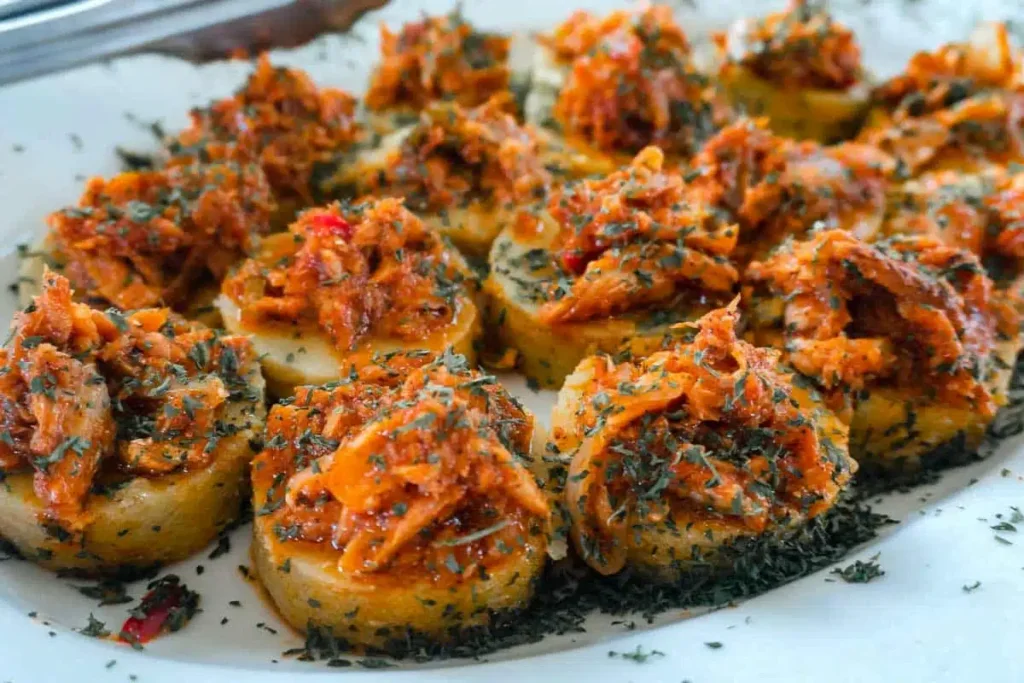
Forget the generic resort buffets – Antiguan and Barbudan food is a vibrant tapestry of flavors, fresh ingredients, and surprising influences, offering a taste of paradise on every plate. Here’s why it deserves a spot on your culinary adventure map:
A Fusion Fiesta: A Legacy of Cultural Exchange
Antigua and Barbuda’s history is a fascinating blend of indigenous Arawak and Carib cultures, European colonialism, and African influences brought by the slave trade. This rich tapestry is reflected in its cuisine. Imagine dishes like pepperpot, a hearty stew with European roots, infused with the fiery kiss of Scotch Bonnet peppers, a legacy of African influence.
Fungee, a national dish made from cornmeal, is similar to Italian polenta, but often enjoyed with stews or salted cod – a nod to the island’s colonial past. Every bite is a journey through time, telling the story of Antigua and Barbuda’s diverse heritage.
A Celebration of the Sea
Surrounded by crystal-clear waters, fresh seafood is a cornerstone of Antiguan and Barbudan cuisine. Imagine succulent lobster grilled to perfection with a touch of lime and garlic butter. Local fishermen bring in a bounty of fish like mahi-mahi, snapper, and kingfish, all transformed into delightful dishes.
Lobster cooked in creamy coconut sauce or stews brimming with shrimp and conch are just a few examples of the island’s love affair with the sea.
A World of Fruits and Vegetables
Antigua and Barbuda’s fertile volcanic soil yields a bounty of fresh fruits and vegetables. These vibrant ingredients add a burst of color and freshness to every dish. Imagine stews infused with the sweet and tangy flavors of mango, pineapple, and passion fruit.
Plantains, a versatile starchy fruit, are enjoyed fried, boiled, or roasted, offering a delicious accompaniment to savory meals. Local greens like callaloo and spinach add a healthy touch to stews and soups. This focus on fresh, local produce ensures that every bite is bursting with the natural goodness of the islands.
Comfort Food with a Caribbean Twist
Antigua and Barbuda excels in comfort food with a unique Caribbean twist. Take “Ducana,” a dish made from grated green bananas and sweet potatoes, boiled and seasoned with coconut milk. Unlike ordinary mashed potatoes, Ducana offers a delightful texture and a subtle sweetness.
“Saltfish and Chop-Up” is another beloved dish featuring salted cod (fish) combined with a medley of chopped, seasoned vegetables. These heartwarming dishes showcase the island’s love for familiar textures with surprising flavor profiles.
A Touch of Sweetness
No Caribbean cuisine is complete without its sweet treats. Antigua and Barbuda offers a delectable array of desserts, many infused with local flavors. “Black Cake,” a rich fruit cake soaked in rum, is a popular celebratory dish. “Guava Duff,” a steamed cake filled with stewed guava, offers a delightful balance of sweet and tart.
Don’t forget the local rum, perfect for sipping on its own or used in creative cocktails.
So, the next time you dream of a Caribbean escape, consider venturing beyond the expected. Antigua and Barbuda’s cuisine, with its unique blend of historical influences, focus on fresh seafood and local produce, and a touch of Caribbean flair, is sure to tantalize your taste buds and leave you wanting more.
Embrace the unexpected flavors and embark on a delicious journey through this island paradise!
Traditional Antigua and Barbuda Food

Antiguan cuisine is deeply rooted in tradition, with recipes that have stood the test of time. One such dish is pepper pot, a flavorful concoction of okra, spinach, eggplant, and the essential fungi, a cornmeal-based side.
This dish, representing resilience and cultural amalgamation, is a staple in many households and a point of pride for Antiguans.
Breakfast dishes feature saltfish, eggplant (also known as troba), eggs, and lettuce.
Lunches typically include a starch like rice, macaroni, or pasta, accompanied by vegetables or salad, an entree (such as fish, chicken, pork, or beef), and a side dish such as macaroni pie, scalloped potatoes, or plantains.
On Sundays, many people in the country attend church and then prepare a variety of foods at home. Sunday dinner is often enjoyed earlier, around 2:00 pm, as people are typically off work.
What are the Health Implications of Antigua and Barbuda Cuisine?
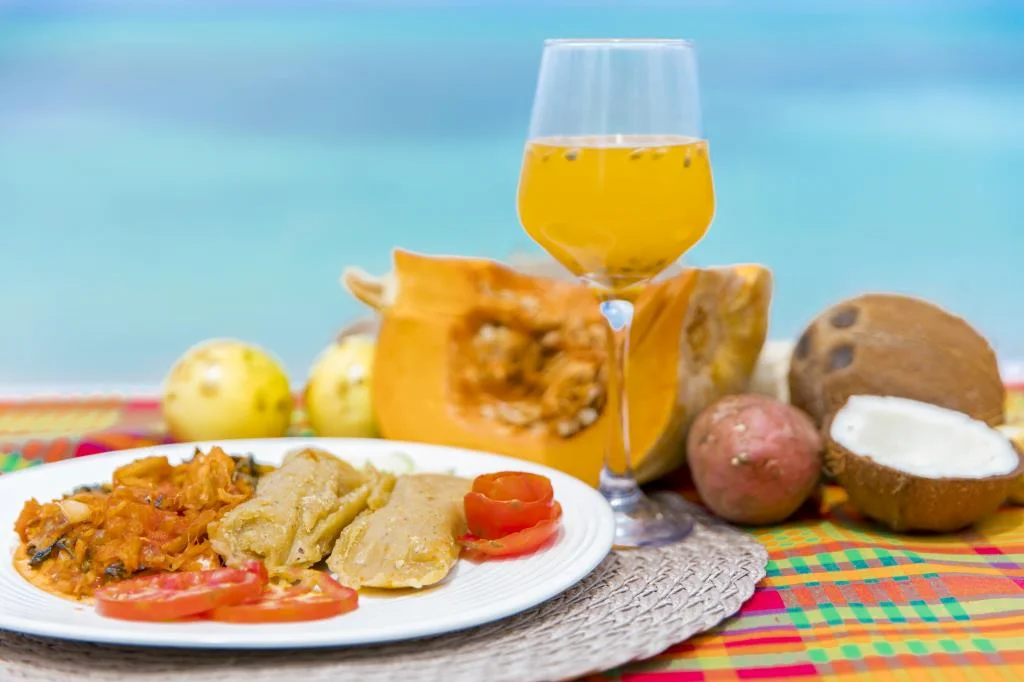
Antigua and Barbuda cuisine is a delicious and diverse blend of tropical and exotic flavors, influenced by the indigenous, African, European, and Asian heritage of the islands. However, like any cuisine, it also has some health implications that depend on the quantity and quality of the food consumed.
According to the World Health Organization, the population of Antigua and Barbuda was 92,664 in 2020, with a life expectancy at birth of 76.5 years. The main causes of death in 2019 were ischemic heart disease, stroke, diabetes mellitus, prostate cancer, and breast cancer.
The prevalence of overweight and obesity among people aged 15 and older was 48% in 2016.
References
- Antigua and Barbuda – Country Profile | Health in the Americas (paho.org)
- Antigua and Barbuda (ATG) – Demographics, Health & Infant Mortality – UNICEF DATA
- Antigua and Barbuda (who.int)
Here are some of the health implications of Antigua and Barbuda cuisine:
Positive Health effects of Antigua and Barbuda Cuisine
Antigua and Barbuda cuisine can provide a balanced diet, as it contains carbohydrates, proteins, fats, vitamins, minerals, and fiber. Seafood is a good source of omega-3 fatty acids, which can lower the risk of cardiovascular diseases and improve brain function.
Spices can add flavor and aroma to the dishes, and also have anti-inflammatory, antioxidant, and antimicrobial properties. Fruits and vegetables can provide vitamins, antioxidants, and phytochemicals, which can prevent chronic diseases, such as cancer, diabetes, and inflammation.
Negative Health effects of Antigua and Barbuda Cuisine
Antigua and Barbuda cuisine can also pose some health risks, such as high consumption of animal fats, salt, and sugar. Animal fats, such as lard, butter, and sour cream, are rich in saturated fats and cholesterol, which can increase the risk of cardiovascular diseases, such as high blood pressure, atherosclerosis, and heart attack.
Salt and sugar are used to preserve and flavor food, but excessive intake can cause problems such as high blood pressure, obesity, diabetes, tooth decay, and kidney damage.
Antigua and Barbuda cuisine can be enjoyed in moderation, but it is advisable to limit the intake of animal fats, salt, and sugar, and to increase the intake of fruits and vegetables. It is also recommended to choose lean meats, such as poultry and fish, over fatty meats, such as pork and sausage.
Antigua and Barbuda Food’s National Dish
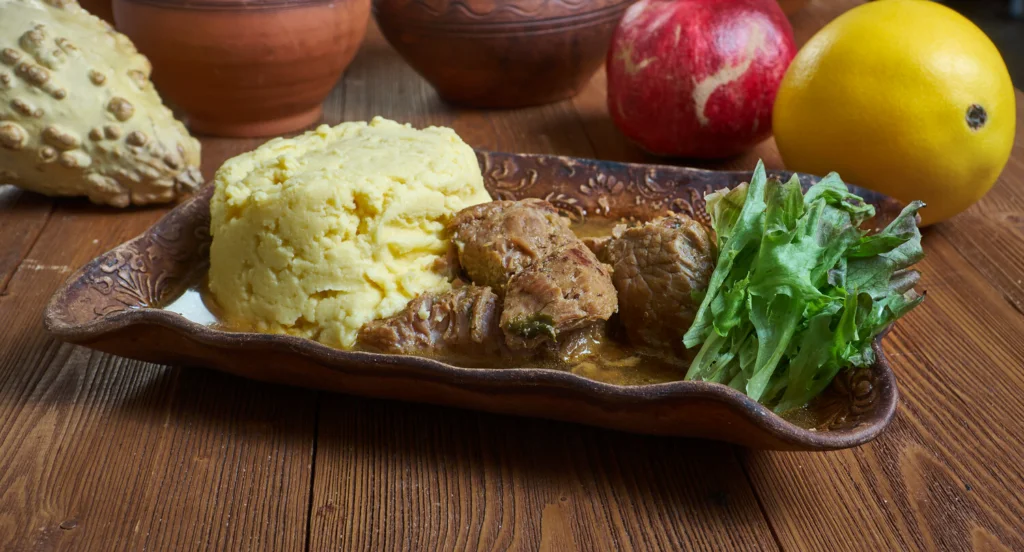
Antigua and Barbuda cuisine refers to the culinary traditions of the islands in the Caribbean. Fungie, pronounced “foon-jee,” and pepperpot are the official dishes and a source of pride for the country.
The pride of Antiguan cuisine is pepper pot. This hearty stew reflects the resilience of the island’s people and the fusion of diverse cultural influences.
Prepared with skill and love, pepper pot captures the essence of Antiguan heritage and is a symbol of unity and strength.
Exploring Antigua and Barbuda Food Ingredients: The Flavors of Antigua and Barbuda Cuisine
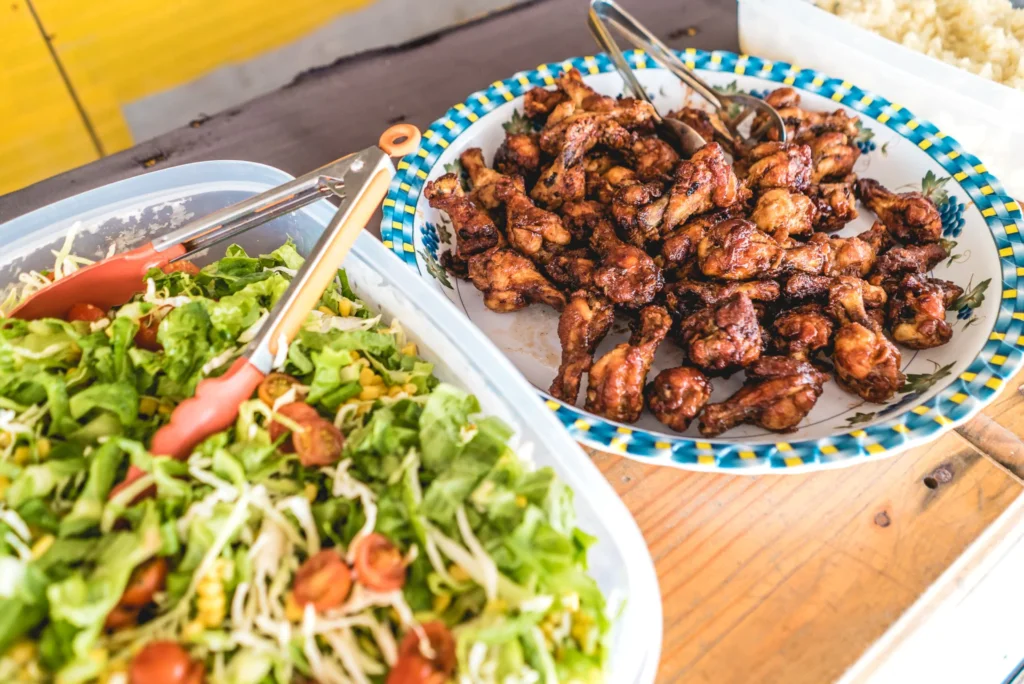
To truly savor the essence of Antiguan cuisine, one must explore the unique ingredients that define its flavors.
From the starchy goodness of breadfruit to the rich and savory saltfish, and the sweet juiciness of the Antiguan black pineapple, each ingredient contributes to the vibrant tapestry of flavors that characterize this Caribbean culinary experience.
As you embark on a journey through Antigua and Barbuda’s markets and kitchens, these ingredients offer a taste of the islands’ rich cultural heritage and culinary prowess.
Antigua and Barbuda Recipes to Try at Home
Embarking on a culinary adventure through Antigua and Barbuda doesn’t necessarily require a passport – the heartwarming flavors of this Balkan nation can be savored right in your own kitchen.
Antigua Food – Ducana

History and Region of Ducana
Ducana is a beloved traditional dish from Antigua and Barbuda, deeply rooted in the culinary history of the Caribbean. Originating from the Afro-Caribbean heritage of the islands, Ducana reflects the fusion of African, Amerindian, and European influences that characterize the region’s gastronomy.
Ingredients for Antigua Food – Ducana
- 2 cups grated sweet potatoes
- 1 cup grated coconut
- 1 cup flour
- 1 cup brown sugar
- 1/2 teaspoon grated nutmeg
- 1/2 teaspoon cinnamon
- 1/4 teaspoon salt
- Banana leaves or foil for wrapping
Antigua Food – Ducana Recipe
Preparation
- Grate the sweet potatoes and coconut.
- Mix the grated sweet potatoes and coconut in a large bowl.
Dry Ingredients
- In a separate bowl, combine the flour, brown sugar, grated nutmeg, cinnamon, and salt.
Combine
- Gradually add the dry ingredients to the sweet potato and coconut mixture, stirring well until it forms a thick batter.
Wrapping
- Cut banana leaves into 8-inch squares or use foil if banana leaves are unavailable.
- Place a portion of the batter onto each leaf or foil.
Folding
- Fold the banana leaves or foil, creating a packet and securing the batter inside.
Boiling
- Bring a large pot of water to a boil.
- Gently place the wrapped Ducana into the boiling water.
- Boil for approximately 1 to 1.5 hours, ensuring the packets are fully submerged.
Cooling
- Remove from water and let them cool before unwrapping.
Serving Details
- Serves: 4-6 people
- Cooking Time: 1.5 hours
- Calories: (Caloric values can vary based on specific brands and quantities used. It’s advisable to calculate calories based on the precise ingredients and their amounts.)
Antigua Food – Fungee & Pepperpot
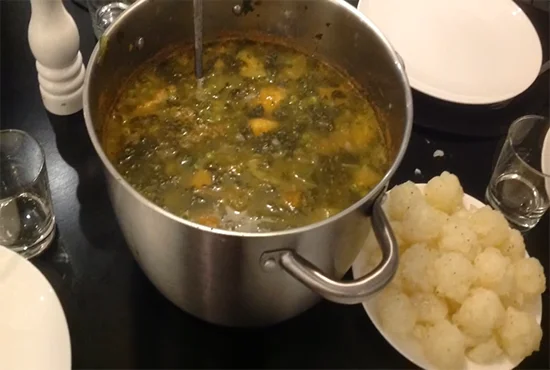
History and Region of Fungee & Pepperpot
Fungee and Pepperpot is a quintessential dish hailing from Antigua and Barbuda, deeply intertwined with the country’s rich history and cultural heritage. This traditional meal showcases the Afro-Caribbean influences prominent in the region, with Fungee representing a cornmeal-based side and Pepperpot symbolizing the fusion of diverse cultural culinary traditions.
Ingredients for Antigua Food – Fungee & Pepperpot
Fungee:
- 2 cups cornmeal
- 4 cups water
- Salt to taste
Pepperpot:
- 1 lb salted beef or salted pork, cut into pieces
- 1 large onion, chopped
- 2 cloves garlic, minced
- 1 eggplant, diced
- 2 okras, sliced
- 1 bunch spinach or callaloo, chopped
- 1 can coconut milk
- 1 tablespoon oil
- 1 tablespoon tomato paste
- Salt and pepper to taste
Fungee Recipe
Boiling Cornmeal
- Boil 4 cups of water in a pot.
- Gradually add 2 cups of cornmeal to the boiling water, stirring continuously to avoid lumps.
- Add salt to taste and keep stirring until the mixture thickens.
Forming Fungee
- Once thickened, reduce heat and continue stirring until the cornmeal is fully cooked.
- Mold the mixture into a rounded shape on a plate.
Pepperpot Recipe
Preparing Meat
- Soak salted beef or pork in water to remove excess salt.
- In a pot, sauté chopped onions and minced garlic in oil until golden.
Cooking Pepperpot
- Add the soaked meat to the pot and brown.
- Stir in tomato paste and cook for a few minutes.
- Pour in coconut milk, add diced eggplant, sliced okra, and chopped spinach or callaloo.
- Season with salt and pepper to taste.
- Simmer until all ingredients are tender.
Serving Details
- Serves: 4-6 people
- Cooking Time: Fungee (30 minutes), Pepperpot (1.5 hours)
- Calories: (Caloric values can vary based on specific brands and quantities used. It’s advisable to calculate calories based on the precise ingredients and their amounts.)
Antigua Food – Antiguan Black Pineapple
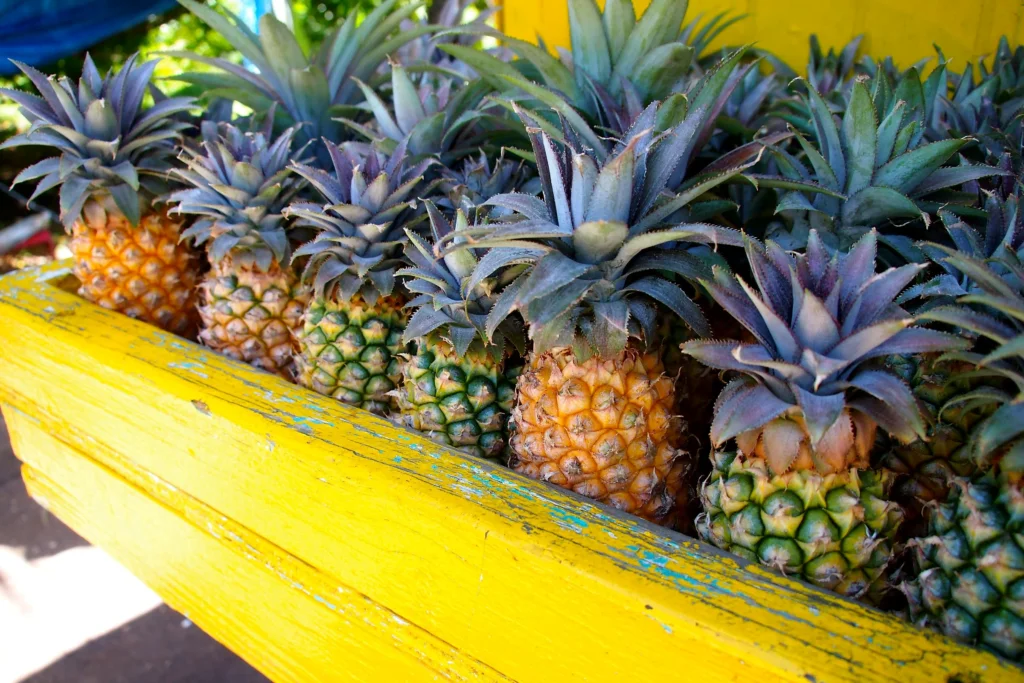
History and Region of Antiguan Black Pineapple
The Antiguan Black Pineapple is not merely a fruit; it’s a symbol of the lush tropical paradise that is Antigua and Barbuda. Originating from the Caribbean, this unique pineapple variety thrives in the region’s fertile soils and warm climate, embodying the sun-soaked essence of the islands.
The history of the Antiguan Black Pineapple is intertwined with the agricultural traditions of Antigua and Barbuda, reflecting the resilience and vibrancy of the local culture.
Ingredients for Antigua Food – Antiguan Black Pineapple
- Fresh Antiguan Black Pineapple
Antigua Food – Antiguan Black Pineapple Recipe
Selection
- Choose a ripe Antiguan Black Pineapple. Look for a vibrant golden color and a sweet fragrance at the base.
Preparation
- Wash the pineapple thoroughly.
- Trim off the crown and base.
Peeling
- Stand the pineapple upright and slice off the skin, ensuring you remove any “eyes.”
Slicing
- Cut the pineapple into bite-sized wedges or chunks.
Serving
- Serve the fresh Antiguan Black Pineapple as a refreshing snack or dessert.
Serving Details
- Serves: 2-4 people
- Preparation Time: 10 minutes
- Calories: (Caloric values can vary based on the size of the pineapple and serving portions. It’s advisable to calculate calories based on the precise quantity consumed.)
Antigua Food – Antiguan Butter Bread

History and Region of Antiguan Butter Bread
Antiguan Butter Bread is a delightful culinary creation from the heart of the Caribbean, specifically Antigua and Barbuda.
Rooted in the region’s rich cultural heritage, this bread reflects the fusion of African, Amerindian, and European influences that shape the islands’ gastronomic traditions. The recipe’s history is a testament to the resilience and creativity of the Antiguan people.
Ingredients for Antigua Food – Antiguan Butter Bread
- 4 cups all-purpose flour
- 1/2 cup sugar
- 1 teaspoon salt
- 1 packet (2 1/4 teaspoons) active dry yeast
- 1/2 cup unsalted butter, melted
- 1 cup warm milk
- 1 large egg
- 1 teaspoon vanilla extract
Antigua Food – Antiguan Butter Bread Recipe
Activate Yeast
- In a bowl, combine warm milk and sugar. Sprinkle yeast over the mixture and let it sit for about 5-10 minutes until it becomes frothy.
Mix Dry Ingredients
- In a large mixing bowl, combine flour and salt.
Combine Wet Ingredients
- To the frothy yeast mixture, add melted butter, beaten egg, and vanilla extract.
Form Dough
- Slowly add the wet ingredients to the dry ingredients, mixing to form a soft dough.
Knead
- Turn the dough onto a floured surface and knead for about 8-10 minutes until it becomes smooth and elastic.
Rise
- Place the dough in a greased bowl, cover with a damp cloth, and let it rise in a warm place for 1-2 hours or until it doubles in size.
Shape and Second Rise
- Punch down the risen dough and shape it into a loaf. Place it in a greased loaf pan and let it rise for an additional 30-45 minutes.
Bake
- Preheat the oven to 350°F (175°C). Bake the bread for 25-30 minutes or until golden brown.
Enjoy
- Allow the Antiguan Butter Bread to cool before slicing. Serve and savor the delicious flavors of the Caribbean.
Serving Details
- Serves: 8-10 people
- Preparation Time: 2.5-3 hours (including rising time)
- Calories: (Caloric values can vary based on specific brands and quantities used. It’s advisable to calculate calories based on the precise ingredients and their amounts.)
Antigua Food – Saltfish

History and Region of Saltfish in Antigua and Barbuda
Saltfish holds a significant place in the culinary heritage of Antigua and Barbuda, reflecting the historical influences of European colonizers and African slaves on the islands.
Preserving fish with salt became a necessity in the absence of refrigeration, and this practice evolved into a distinctive dish that represents the resilience and resourcefulness of the Caribbean people.
Ingredients for Antigua Food – Saltfish
- 1 lb salted codfish
- 2 cups all-purpose flour
- 1 large onion, finely chopped
- 2 bell peppers (red and green), diced
- 2 medium tomatoes, chopped
- 2 cloves garlic, minced
- 2 tablespoons vegetable oil
- 1 teaspoon black pepper
- 1 teaspoon thyme
- 1 teaspoon paprika
- 1 teaspoon scallion, chopped
- 1 teaspoon hot pepper (optional)
- Fresh parsley for garnish
- Lime wedges for serving
Antigua Food – Saltfish Recipe
Soaking Saltfish
- Rinse the salted codfish under cold water to remove excess salt.
- Soak the codfish in a bowl of cold water for at least 4-6 hours or overnight, changing the water several times.
Boiling Saltfish
- Place the soaked codfish in a pot, cover with water, and bring to a boil.
- Boil for 10-15 minutes until the fish is tender.
- Drain and flake the fish, removing any bones and skin.
Preparing Vegetables
- In a skillet, heat vegetable oil and sauté chopped onions, bell peppers, tomatoes, and minced garlic until softened.
Cooking Saltfish
- Add the flaked codfish to the skillet and stir to combine with the sautéed vegetables.
- Season with black pepper, thyme, paprika, scallion, and hot pepper if desired.
- Cook for an additional 5-7 minutes until flavors meld.
Serving
- Garnish with fresh parsley and serve the saltfish hot.
- Accompany with lime wedges for a burst of citrus flavor.
Serving Details
- Serves: 4-6 people
- Preparation Time: 4-6 hours (soaking), 30 minutes (cooking)
- Calories: (Caloric values can vary based on specific brands and quantities used. It’s advisable to calculate calories based on the precise ingredients and their amounts.)
Antigua Food – Jerk chicken

History and Region of Jerk Chicken in Antigua and Barbuda
Jerk chicken, a culinary delight originating from the Caribbean, holds a special place in the hearts of Antiguans and Barbudans. The dish’s history is deeply rooted in the region’s Afro-Caribbean heritage, with influences from indigenous ingredients and traditional cooking methods.
Jerk chicken showcases the vibrant flavors and rich cultural tapestry that define the gastronomy of Antigua and Barbuda.
Ingredients for Antigua Food – Jerk chicken
- 2.5 to 3 lbs chicken pieces (drumsticks, thighs, or wings)
- 1 cup green onions, chopped
- 1 medium onion, chopped
- 4 cloves garlic, minced
- 2 Scotch bonnet peppers, seeds removed and chopped
- 1 tablespoon fresh thyme leaves
- 1 tablespoon ground allspice
- 1 tablespoon brown sugar
- 1 tablespoon soy sauce
- 1 tablespoon vegetable oil
- 1 teaspoon ground cinnamon
- 1 teaspoon ground nutmeg
- 1 teaspoon black pepper
- 1 teaspoon salt
- Juice of 2 limes or lemons
Jerk Chicken Antigua Food – Jerk chicken
Prepare Marinade
- In a blender or food processor, combine green onions, onion, garlic, Scotch bonnet peppers, thyme, allspice, brown sugar, soy sauce, vegetable oil, cinnamon, nutmeg, black pepper, salt, and lime or lemon juice.
- Blend until a smooth marinade forms.
Marinate Chicken
- Place chicken pieces in a large bowl or resealable plastic bag.
- Pour the marinade over the chicken, ensuring each piece is well-coated.
- Marinate in the refrigerator for at least 4 hours or overnight for optimal flavor.
Preheat Grill
- Preheat a grill or barbecue to medium-high heat.
Grill Jerk Chicken
- Remove chicken from the marinade and let excess drip off.
- Grill chicken for about 20-25 minutes, turning occasionally, until fully cooked and charred on the edges.
Serve
- Let the jerk chicken rest for a few minutes before serving.
- Garnish with additional chopped green onions and lime wedges.
Serving Details
- Serves: 4-6 people
- Marinating Time: 4 hours to overnight
- Grilling Time: 20-25 minutes
- Calories: (Caloric values can vary based on specific brands and quantities used. It’s advisable to calculate calories based on the precise ingredients and their amounts.)
Antigua Food – Conch

History and Region of Conch in Antigua and Barbuda
Conch, a delectable seafood delicacy, plays a prominent role in the culinary traditions of Antigua and Barbuda. The history of conch consumption in the Caribbean dates back centuries, with the indigenous people and later, European settlers, incorporating it into their diets.
Today, conch remains a beloved dish in the region, showcasing the influence of the Caribbean Sea on the islands’ gastronomy.
Ingredients for Antigua Food – Conch
- 1 lb conch meat, cleaned and tenderized
- 1 cup bell peppers (red and green), diced
- 1 cup tomatoes, diced
- 1/2 cup onions, finely chopped
- 1/4 cup celery, chopped
- 2 cloves garlic, minced
- 1 Scotch bonnet pepper, seeds removed and finely chopped
- 1/4 cup fresh cilantro, chopped
- 1/4 cup fresh lime juice
- 1/4 cup orange juice
- 2 tablespoons vegetable oil
- Salt and pepper to taste
Antigua Food – Conch Recipe
Clean and Tenderize Conch
- Clean the conch thoroughly, removing any remaining debris.
- Tenderize the conch meat by pounding it gently to break down its fibrous texture.
Prepare Vegetables
- In a bowl, combine diced bell peppers, tomatoes, onions, celery, minced garlic, Scotch bonnet pepper, and fresh cilantro.
Marinate Conch
- Place the cleaned and tenderized conch in the vegetable mixture.
- Pour lime juice, orange juice, and vegetable oil over the conch.
- Season with salt and pepper to taste.
- Allow the conch to marinate for at least 1 hour.
Cook Conch
- Heat a skillet or pan over medium-high heat.
- Add the marinated conch and vegetables, cooking for approximately 5-7 minutes or until the conch is cooked through.
Serve
- Garnish with additional cilantro and lime wedges.
- Serve the conch dish hot.
Serving Details
- Serves: 4-6 people
- Marinating Time: 1 hour
- Cooking Time: 5-7 minutes
- Calories: (Caloric values can vary based on specific brands and quantities used. It’s advisable to calculate calories based on the precise ingredients and their amounts.)
Antigua Food – Goat water

History and Region of Goat Water in Antigua and Barbuda
Goat Water, a hearty and flavorful stew, has deep roots in the culinary history of Antigua and Barbuda. Originating from the blending of African, Amerindian, and European culinary influences on the islands, Goat Water has evolved into a beloved national dish.
Its rich history reflects the cultural diversity and resilience of the people of Antigua and Barbuda.
Ingredients for Antigua Food – Goat water
- 2 lbs goat meat, cut into chunks
- 2 cups water
- 1 cup pumpkin, diced
- 1 cup carrots, diced
- 1 cup potatoes, diced
- 1 cup dasheen (taro), diced
- 1 cup green bananas, sliced
- 1 cup spinach or callaloo, chopped
- 1 cup okra, sliced
- 1 cup flour dumplings (optional)
- 1 large onion, chopped
- 3 cloves garlic, minced
- 2 sprigs thyme
- 2 bay leaves
- 2 tablespoons vegetable oil
- Salt and pepper to taste
- Hot pepper sauce (optional)
Antigua Food – Goat water Recipe
Prepare Goat Meat
- Clean and wash the goat meat thoroughly.
- In a large pot, bring 2 cups of water to a boil and add the goat meat. Simmer until the meat is tender.
Add Vegetables
- Add diced pumpkin, carrots, potatoes, dasheen, green bananas, spinach or callaloo, and okra to the pot.
Make Dumplings (Optional)
- In a bowl, mix flour with a pinch of salt and enough water to form a dough.
- Shape the dough into small dumplings and add them to the pot.
Seasoning
- In a separate pan, sauté chopped onions and minced garlic in vegetable oil until golden.
- Add the sautéed mixture to the pot, along with thyme, bay leaves, salt, and pepper.
- Simmer until all the ingredients are fully cooked and flavors meld.
Serve
- Adjust seasoning to taste and add hot pepper sauce if desired.
- Serve Goat Water hot, and enjoy the flavors of this traditional Antiguan stew.
Serving Details
- Serves: 6-8 people
- Cooking Time: 2-3 hours
- Calories: (Caloric values can vary based on specific brands and quantities used. It’s advisable to calculate calories based on the precise ingredients and their amounts.)
Antigua Food – Roti

History and Region of Roti in Antigua and Barbuda
Roti, a beloved and versatile dish, has found a home in the culinary landscape of Antigua and Barbuda, reflecting the Indian influence on the Caribbean cuisine. This unleavened flatbread, often paired with savory fillings, has become a staple that showcases the diverse cultural heritage of the islands.
The history of roti in Antigua and Barbuda is a testament to the fusion of flavors brought by Indian indentured laborers who arrived in the Caribbean.
Ingredients for Antigua Food – Roti
Roti Dough:
- 3 cups all-purpose flour
- 1 teaspoon baking powder
- 1/2 teaspoon salt
- Water (as needed for kneading)
Curry Filling:
- 2 lbs chicken or goat meat, cubed
- 2 tablespoons curry powder
- 1 large onion, chopped
- 3 cloves garlic, minced
- 1 tablespoon ginger, minced
- 2 tablespoons vegetable oil
- 2 large potatoes, diced
- 1 cup carrots, diced
- 1 cup green peas
- 1 cup coconut milk
- Salt and pepper to taste
Antigua Food – Roti Recipe
Prepare Roti Dough
- In a large bowl, combine flour, baking powder, and salt.
- Gradually add water and knead the mixture until it forms a smooth, elastic dough.
- Cover the dough and let it rest for 30 minutes.
Make Roti Balls
- Divide the dough into small balls, roughly the size of golf balls.
Roll Out Roti
- Roll out each ball into a thin, flat circle using a rolling pin.
Cook Roti
- Heat a griddle or flat pan over medium-high heat.
- Cook each roti for 1-2 minutes on each side or until they puff up and develop light brown spots.
Prepare Curry Filling
- In a separate pot, heat vegetable oil and sauté chopped onions, minced garlic, and minced ginger until aromatic.
- Add curry powder and cook for an additional 1-2 minutes.
- Add cubed meat and cook until browned.
- Stir in diced potatoes, carrots, green peas, and coconut milk.
- Simmer until the meat is tender and the vegetables are cooked through.
- Season with salt and pepper to taste.
Serve
- Place a scoop of the curry filling in the center of each roti.
- Fold the sides of the roti over the filling, creating a pocket.
- Serve the roti hot, allowing the flavorful filling to complement the soft, flaky bread.
Serving Details
- Serves: 4-6 people
- Preparation Time: 45 minutes
- Cooking Time: 30 minutes
- Calories: (Caloric values can vary based on specific brands and quantities used. It’s advisable to calculate calories based on the precise ingredients and their amounts.)
Antigua Food – Johnny Cakes
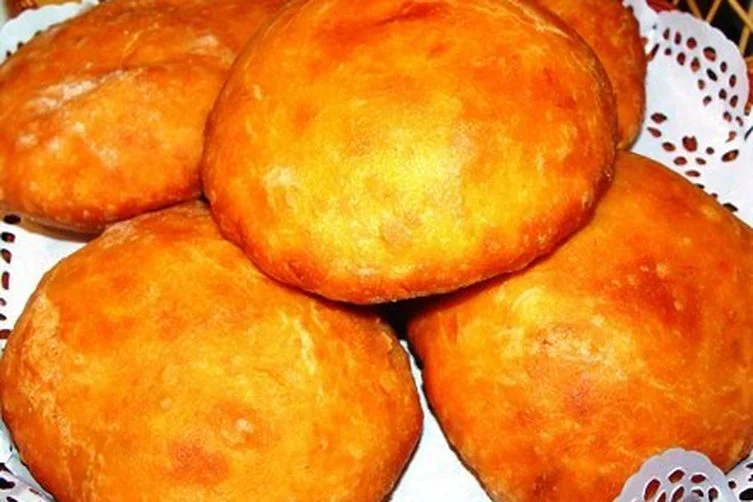
History and Region of Johnny Cakes in Antigua and Barbuda
Johnny Cakes, a delightful staple in the cuisine of Antigua and Barbuda, trace their origins to the Caribbean’s rich cultural tapestry. Also known as “journey cakes,” these fried or baked dough delicacies have historical roots in the region’s African and European influences.
The name “journey cakes” suggests their portability, making them a convenient and satisfying choice for travelers and locals alike.
Ingredients for Antigua Food – Johnny Cakes
- 2 cups all-purpose flour
- 1 tablespoon sugar
- 1 teaspoon baking powder
- 1/2 teaspoon salt
- 1/4 cup unsalted butter, cold and cubed
- 3/4 cup milk
- Vegetable oil for frying
Antigua Food – Johnny Cakes Recipe
Prepare Dry Ingredients
- In a mixing bowl, combine all-purpose flour, sugar, baking powder, and salt.
Incorporate Butter
- Add cold, cubed butter to the dry ingredients.
- Use your fingers or a pastry cutter to incorporate the butter until the mixture resembles coarse crumbs.
Form Dough
- Gradually add milk to the mixture, stirring until a soft dough forms.
- Knead the dough briefly until it comes together.
Shape Johnny Cakes
- Pinch off golf ball-sized portions of dough and shape them into rounds.
Heat Oil
- In a frying pan, heat vegetable oil over medium heat.
Fry Johnny Cakes
- Carefully place the shaped dough rounds into the hot oil.
- Fry until golden brown on both sides, approximately 2-3 minutes per side.
Drain and Serve
- Remove the Johnny Cakes from the oil and place them on paper towels to drain excess oil.
- Serve the Johnny Cakes warm, either on their own or with your favorite accompaniments.
Serving Details
- Serves: 4-6 people
- Preparation Time: 15 minutes
- Cooking Time: 10 minutes
- Calories: (Caloric values can vary based on specific brands and quantities used. It’s advisable to calculate calories based on the precise ingredients and their amounts.)
Antigua Food – Tamarind Balls
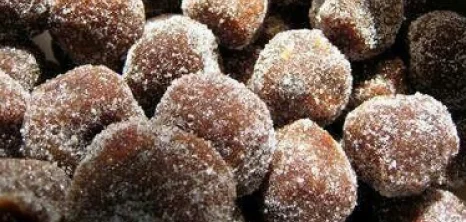
History and Region of Tamarind Balls in Antigua and Barbuda
Tamarind Balls, a delightful treat from Antigua and Barbuda, showcase the vibrant flavors of the Caribbean. Tamarind, a sweet and tangy tropical fruit, takes center stage in this popular confection.
With roots deeply embedded in the region’s agricultural abundance and culinary diversity, Tamarind Balls embody the essence of Antiguan and Barbudan sweets.
Ingredients for Antigua Food – Tamarind Balls
- 2 cups tamarind pulp (seedless)
- 1 cup granulated sugar
- 1/2 teaspoon ground cinnamon
- 1/4 teaspoon ground ginger
- 1/4 teaspoon ground cloves
- 1 cup grated coconut (optional, for coating)
- Water (as needed)
Antigua Food – Tamarind Balls Recipe
Extract Tamarind Pulp
- Remove the seeds from tamarind pods to obtain seedless tamarind pulp.
Mix Ingredients
- In a bowl, combine tamarind pulp, granulated sugar, ground cinnamon, ground ginger, and ground cloves.
- Mix the ingredients thoroughly, ensuring an even distribution.
Form Tamarind Balls
- Take small portions of the mixture and roll them into bite-sized balls.
Optional Coconut Coating
- If desired, roll the tamarind balls in grated coconut for an additional layer of flavor.
Set and Serve
- Allow the tamarind balls to set for a few hours or refrigerate to firm up.
- Serve the Tamarind Balls as a delightful snack or dessert.
Serving Details
- Serves: 6-8 people
- Preparation Time: 30 minutes
- Setting Time: 2 hours
- Calories: (Caloric values can vary based on specific brands and quantities used. It’s advisable to calculate calories based on the precise ingredients and their amounts.)
Antigua Food – Shawarma
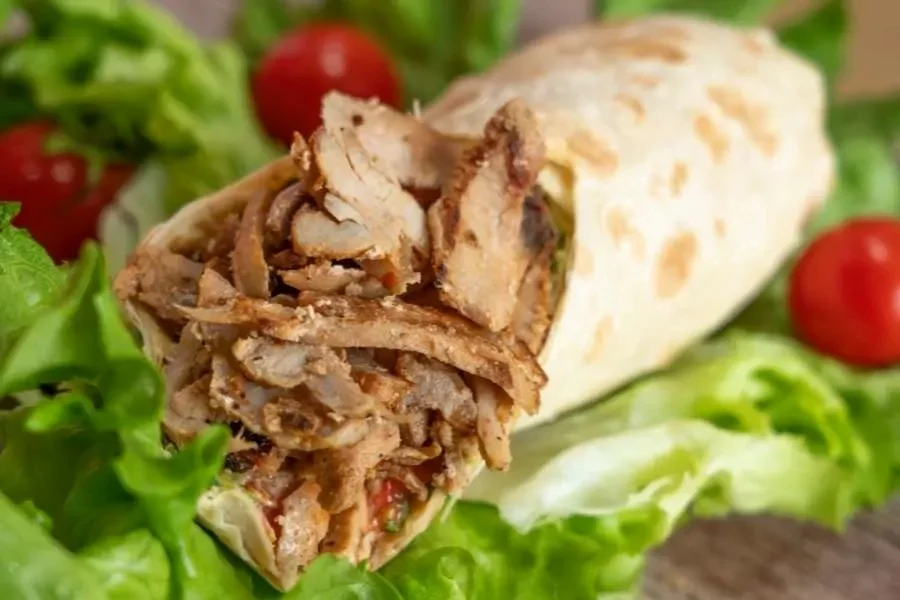
History and Region of Shawarma in Antigua and Barbuda
Shawarma, a culinary delight known for its savory, spiced meats, has found a place in the diverse food culture of Antigua and Barbuda. Originating from the Middle East, Shawarma made its way to the Caribbean, bringing its unique blend of flavors and textures.
In Antigua and Barbuda, Shawarma has been embraced, adapted, and infused with local influences, creating a fusion dish that captivates the taste buds.
Ingredients for Antigua Food – Shawarma
Marinade:
- 2 lbs boneless chicken thighs, thinly sliced
- 1 cup plain yogurt
- 4 cloves garlic, minced
- 2 teaspoons ground cumin
- 2 teaspoons ground coriander
- 1 teaspoon ground paprika
- 1 teaspoon ground turmeric
- 1 teaspoon ground cinnamon
- Salt and pepper to taste
- 2 tablespoons olive oil
Garlic Sauce:
- 1 cup mayonnaise
- 4 cloves garlic, minced
- 2 tablespoons lemon juice
- Salt to taste
Assembly:
- Pita bread or flatbreads
- Sliced tomatoes
- Sliced cucumbers
- Sliced red onions
- Fresh parsley, chopped
Antigua Food – Shawarma Recipe
Prepare Marinade
- In a bowl, combine yogurt, minced garlic, cumin, coriander, paprika, turmeric, cinnamon, salt, pepper, and olive oil.
- Add the sliced chicken to the marinade, ensuring each piece is well-coated.
- Refrigerate and marinate for at least 2 hours or overnight.
Cook Chicken
- Preheat a grill or skillet over medium-high heat.
- Cook the marinated chicken slices until fully cooked and slightly charred on the edges.
Prepare Garlic Sauce
- In a bowl, mix mayonnaise, minced garlic, lemon juice, and salt to taste. Refrigerate until ready to use.
Assemble Shawarma
- Warm the pita bread or flatbreads.
- Spread a generous amount of garlic sauce on each bread.
- Add slices of cooked chicken, tomatoes, cucumbers, red onions, and chopped parsley.
Serve
- Roll the assembled Shawarma tightly and serve hot.
Serving Details
- Serves: 4-6 people
- Marinating Time: 2 hours to overnight
- Cooking Time: 15-20 minutes
- Calories: (Caloric values can vary based on specific brands and quantities used. It’s advisable to calculate calories based on the precise ingredients and their amounts.)
Antigua Food – Coconut Sugar Cake

History and Region of Coconut Sugar Cake in Antigua and Barbuda
Coconut Sugar Cake is a delectable dessert that reflects the sweet side of Antigua and Barbuda’s culinary heritage. Rooted in the region’s tropical abundance, this treat showcases the versatility of coconut, a staple ingredient in Caribbean cooking.
The history of Coconut Sugar Cake in Antigua and Barbuda is a journey through the flavors of the islands, where coconut and sugar come together to create a delightful confection.
Ingredients for Antigua Food – Coconut Sugar Cake
- 2 cups grated coconut
- 2 cups granulated sugar
- 1 cup water
- 1 teaspoon vanilla extract
- 1/4 teaspoon almond extract (optional)
- 1/4 teaspoon nutmeg, grated
- 1/4 teaspoon cinnamon
- 1/4 teaspoon salt
- 1 tablespoon unsalted butter
Antigua Food – Coconut Sugar Cake Recipe
Prepare Coconut
- Grate fresh coconut to yield 2 cups of grated coconut.
Create Syrup
- In a saucepan, combine granulated sugar, water, vanilla extract, almond extract (if using), nutmeg, cinnamon, salt, and unsalted butter.
- Bring the mixture to a boil, stirring until the sugar dissolves.
Add Coconut
- Add the grated coconut to the syrup and continue cooking over medium heat.
- Stir consistently to prevent burning and cook until the mixture thickens.
Form the Cake
- Once the mixture reaches a fudge-like consistency, pour it onto a greased baking sheet or into a mold.
Cool and Cut
- Allow the Coconut Sugar Cake to cool and set at room temperature or in the refrigerator.
- Once set, cut the cake into squares or desired shapes.
Serve
- Serve the Coconut Sugar Cake as a delightful dessert or snack.
Serving Details
- Serves: 8-10 people
- Preparation Time: 15 minutes
- Cooking Time: 20-25 minutes
- Calories: (Caloric values can vary based on specific brands and quantities used. It’s advisable to calculate calories based on the precise ingredients and their amounts.)
Antigua Food – Fudge

History and Region of Fudge in Antigua and Barbuda
Fudge, a sweet indulgence that has become a cherished treat in Antigua and Barbuda, represents the sweeter side of Caribbean cuisine. While its origins may trace back to European confectionery traditions, the local adaptation in Antigua and Barbuda adds a tropical twist to this delightful dessert.
Fudge has become a symbol of celebration, often enjoyed during festive occasions and gatherings.
Ingredients Antigua Food – Fudge
- 2 cups granulated sugar
- 1/2 cup unsalted butter
- 1/2 cup evaporated milk
- 1/4 cup cocoa powder
- 1/4 teaspoon salt
- 1 teaspoon vanilla extract
- 1 cup chopped nuts (optional)
Antigua Food – Fudge Recipe
Prepare Baking Pan
- Grease a square baking pan or line it with parchment paper.
Combine Ingredients
- In a saucepan, combine granulated sugar, unsalted butter, evaporated milk, cocoa powder, and salt.
Heat Mixture
- Heat the mixture over medium heat, stirring constantly, until it comes to a boil.
Boil and Stir
- Continue boiling the mixture, stirring constantly, until it reaches the soft-ball stage or about 235°F (113°C) on a candy thermometer.
Remove from Heat
- Remove the saucepan from heat and let it cool for a few minutes.
Add Vanilla and Nuts
- Stir in vanilla extract and chopped nuts (if using) until well combined.
Beat the Mixture
- Beat the fudge mixture vigorously until it thickens and begins to lose its gloss.
Pour into Pan
- Quickly pour the fudge into the prepared baking pan, spreading it evenly.
Cool and Cut
- Allow the fudge to cool completely at room temperature or in the refrigerator.
- Once set, cut the fudge into squares or desired shapes.
Serve
- Serve the delicious Antiguan and Barbudan Fudge as a delightful treat for any occasion.
Serving Details
- Serves: 8-10 people
- Preparation Time: 10 minutes
- Cooking Time: 15-20 minutes
- Cooling Time: 2 hours
- Calories: (Caloric values can vary based on specific brands and quantities used. It’s advisable to calculate calories based on the precise ingredients and their amounts.)
Antigua Food – Peanut Brittle

History and Region of Peanut Brittle in Antigua and Barbuda
Peanut Brittle, a delightful confection, holds a special place in the sweet repertoire of Antigua and Barbuda. Originating from a blend of European and African culinary influences, Peanut Brittle has become a beloved treat enjoyed during various celebrations and gatherings in the region.
The sweet and nutty flavors encapsulate the spirit of Caribbean indulgence.
Ingredients for Antigua Food – Peanut Brittle
- 1 cup granulated sugar
- 1/2 cup light corn syrup
- 1 cup roasted peanuts
- 1 tablespoon unsalted butter
- 1 teaspoon vanilla extract
- 1 teaspoon baking soda
- 1/4 teaspoon salt
Antigua Food – Peanut Brittle Recipe
Prepare Baking Sheet
- Grease a baking sheet or line it with parchment paper.
Combine Sugar and Corn Syrup
- In a saucepan, combine granulated sugar and light corn syrup over medium heat.
Cook Sugar Mixture
- Cook the sugar mixture, stirring constantly, until it reaches a golden brown color.
Add Peanuts
- Stir in roasted peanuts, ensuring they are well-coated with the caramelized sugar.
Butter and Vanilla
- Add unsalted butter and vanilla extract to the mixture, stirring until the butter is fully melted.
Add Baking Soda and Salt
- Sprinkle baking soda and salt into the mixture, stirring quickly.
- The mixture will foam up; make sure to incorporate the ingredients thoroughly.
Spread onto Baking Sheet
- Quickly pour the hot peanut mixture onto the prepared baking sheet, spreading it evenly.
Cool and Break
- Allow the Peanut Brittle to cool and harden at room temperature.
- Once set, break the brittle into bite-sized pieces.
Serve
- Serve the Peanut Brittle as a delightful crunchy snack or gift it to friends and family.
Serving Details
- Serves: 6-8 people
- Preparation Time: 10 minutes
- Cooking Time: 15-20 minutes
- Cooling Time: 1 hour
- Calories: (Caloric values can vary based on specific brands and quantities used. It’s advisable to calculate calories based on the precise ingredients and their amounts.)
Antigua Food – Antiguan Bread Pudding
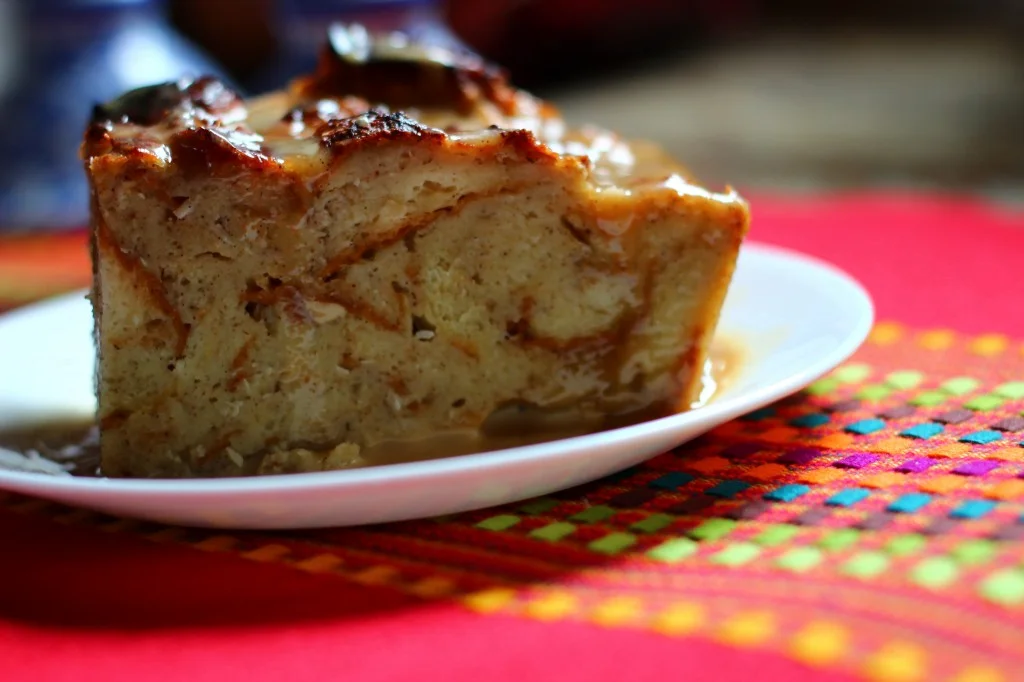
History and Region of Antiguan Bread Pudding
Antiguan Bread Pudding, a classic dessert rooted in the culinary traditions of Antigua and Barbuda, represents a delicious fusion of African, European, and Caribbean influences. This comforting and satisfying treat showcase the resourcefulness of the islands’ inhabitants, turning simple ingredients into a delightful culinary experience.
As a popular dessert in local homes and celebrations, Antiguan Bread Pudding embodies the sweet essence of the region.
Ingredients for Antigua Food – Antiguan Bread Pudding
- 6 cups bread, stale and torn into pieces
- 2 cups milk
- 1 cup granulated sugar
- 3 eggs, beaten
- 1/2 cup unsalted butter, melted
- 1 teaspoon vanilla extract
- 1/2 teaspoon ground cinnamon
- 1/4 teaspoon ground nutmeg
- 1/2 cup raisins
- 1/2 cup chopped nuts (optional)
Antigua Food – Antiguan Bread Pudding Recipe
Preheat Oven
- Preheat the oven to 350°F (175°C).
- Grease a baking dish with butter or cooking spray.
Prepare Bread
- In a large mixing bowl, place torn pieces of stale bread.
Mix Wet Ingredients
- In a separate bowl, whisk together milk, granulated sugar, beaten eggs, melted butter, vanilla extract, ground cinnamon, and ground nutmeg.
Combine Wet and Dry Ingredients
- Pour the wet ingredients over the torn bread in the mixing bowl.
- Gently mix until the bread is evenly coated with the liquid mixture.
Add Raisins and Nuts
- Fold in raisins and chopped nuts (if using).
Let it Sit
- Allow the mixture to sit for about 15-20 minutes, allowing the bread to absorb the liquid.
Bake
- Transfer the bread mixture to the greased baking dish.
- Bake in the preheated oven for 40-45 minutes or until the top is golden brown and a toothpick comes out clean.
Cool and Serve
- Allow the Antiguan Bread Pudding to cool for a few minutes before serving.
- Serve warm, optionally dusted with powdered sugar or topped with a scoop of vanilla ice cream.
Serving Details
- Serves: 8-10 people
- Preparation Time: 20 minutes
- Baking Time: 40-45 minutes
- Calories: (Caloric values can vary based on specific brands and quantities used. It’s advisable to calculate calories based on the precise ingredients and their amounts.)
Antigua Food – Bun and Cheese
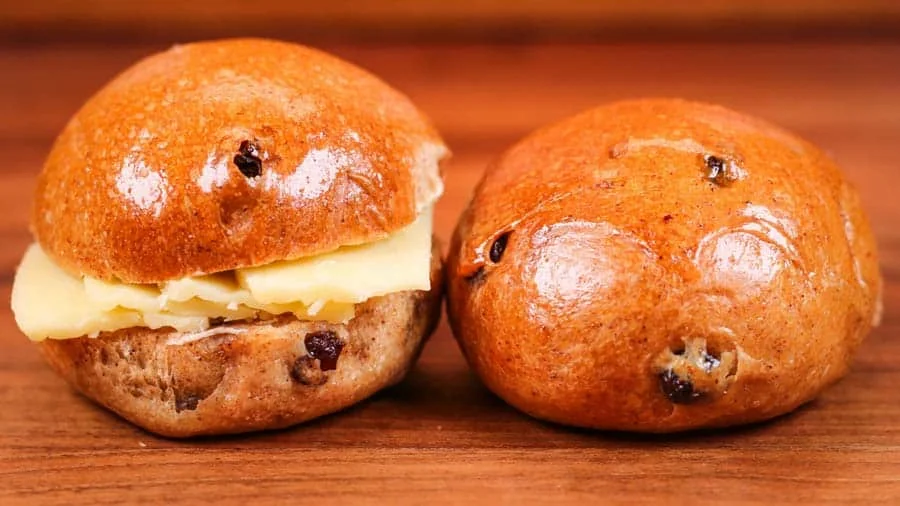
History and Region of Bun and Cheese in Antigua and Barbuda
Bun and Cheese, a flavorful and hearty combination, has become a beloved snack in the culinary landscape of Antigua and Barbuda. With roots in British and Caribbean traditions, this delightful pairing of sweet, spiced bun and rich, tangy cheese reflects the cultural diversity and influences that shape the region’s cuisine.
Often enjoyed during festive occasions and gatherings, Bun and Cheese embody the essence of comfort and indulgence.
Ingredients for Antigua Food – Bun and Cheese
Bun:
- 4 cups all-purpose flour
- 1 cup brown sugar
- 1 teaspoon baking powder
- 1 teaspoon ground cinnamon
- 1/2 teaspoon ground nutmeg
- 1/2 teaspoon salt
- 1/2 cup unsalted butter, melted
- 1/2 cup milk
- 1/4 cup molasses
- 1 egg, beaten
Cheese:
- 1 pound sharp cheddar cheese, sliced
Antigua Food – Bun and Cheese Recipe
Preheat Oven
- Preheat the oven to 350°F (175°C).
- Grease and flour a baking pan.
Mix Dry Ingredients
- In a large bowl, combine all-purpose flour, brown sugar, baking powder, ground cinnamon, ground nutmeg, and salt.
Add Wet Ingredients
- Make a well in the center of the dry ingredients and add melted unsalted butter, milk, molasses, and beaten egg.
- Mix the ingredients until a soft dough forms.
Shape the Bun
- Turn the dough onto a floured surface and knead lightly.
- Shape the dough into a round bun and place it in the prepared baking pan.
Bake
- Bake the bun in the preheated oven for 25-30 minutes or until a toothpick inserted into the center comes out clean.
Cool
- Allow the bun to cool in the pan for a few minutes before transferring it to a wire rack to cool completely.
Serve with Cheese
- Slice the bun and serve it with sharp cheddar cheese.
Serving Details
- Serves: 8-10 people
- Preparation Time: 15 minutes
- Baking Time: 25-30 minutes
- Calories: (Caloric values can vary based on specific brands and quantities used. It’s advisable to calculate calories based on the precise ingredients and their amounts.)
Antigua Food – Conch Water
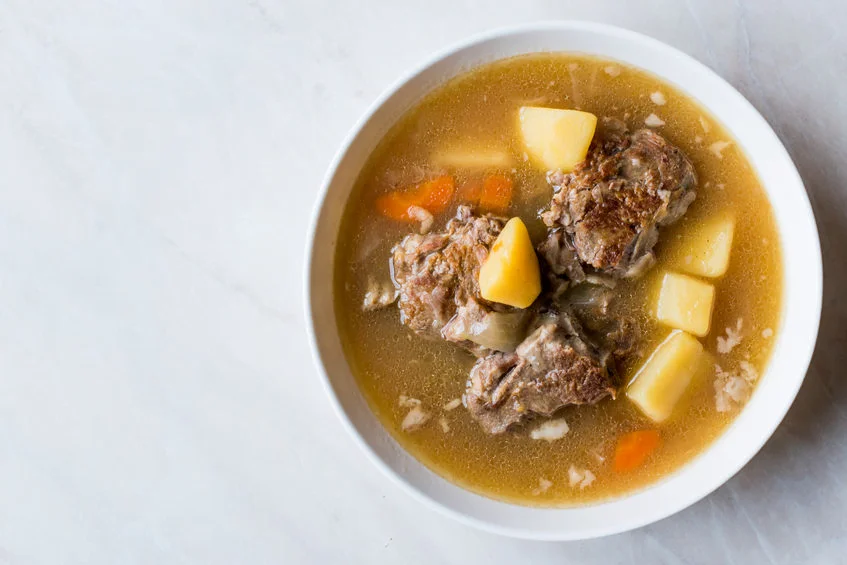
History and Region of Conch Water in Antigua and Barbuda
Conch Water, a savory and rich seafood soup, is a culinary gem that reflects the coastal influence of Antigua and Barbuda. The history of this dish is intertwined with the island’s maritime traditions and the abundance of conch in its waters.
As a popular dish enjoyed by locals and visitors alike, Conch Water showcases the Caribbean’s commitment to fresh and flavorful seafood cuisine.
Ingredients for Antigua Food – Conch Water
- 1 pound conch, cleaned and diced
- 2 tablespoons vegetable oil
- 1 onion, finely chopped
- 2 bell peppers, diced
- 2 tomatoes, chopped
- 2 cloves garlic, minced
- 1 teaspoon thyme, chopped
- 1 teaspoon paprika
- 1 teaspoon hot pepper sauce (adjust to taste)
- 6 cups fish or seafood stock
- Salt and pepper to taste
- 1 cup okra, sliced
- 1 cup yams, diced
- 1 cup corn kernels
- 1 cup spinach, chopped
- 1 lime, cut into wedges for serving
Antigua Food – Conch Water Recipe
Prepare Conch
- Clean and dice the conch into bite-sized pieces.
Sauté Aromatics
- In a large pot, heat vegetable oil over medium heat.
- Sauté chopped onions, diced bell peppers, and minced garlic until softened.
Add Tomatoes and Seasonings
- Add chopped tomatoes, thyme, paprika, and hot pepper sauce.
- Cook until the tomatoes break down and the mixture is aromatic.
Incorporate Conch and Stock
- Add the diced conch to the pot and pour in fish or seafood stock.
- Season with salt and pepper to taste.
Simmer
- Allow the soup to simmer over medium-low heat for 30-40 minutes to allow the flavors to meld.
Add Vegetables
- Add sliced okra, diced yams, corn kernels, and chopped spinach.
- Continue simmering until the vegetables are tender.
Serve
- Ladle Conch Water into bowls and serve hot.
- Accompany with lime wedges for squeezing over the soup.
Serving Details
- Serves: 4-6 people
- Preparation Time: 20 minutes
- Cooking Time: 40 minutes
- Calories: (Caloric values can vary based on specific brands and quantities used. It’s advisable to calculate calories based on the precise ingredients and their amounts.)
Antigua Food – Souse
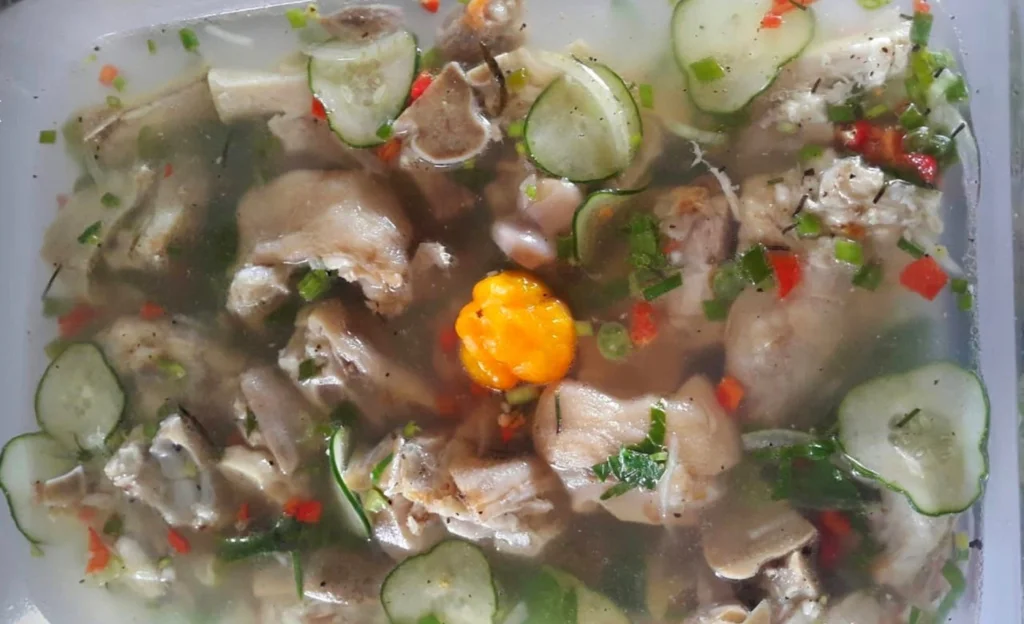
History and Region of Souse in Antigua and Barbuda
Souse, a traditional dish in Antigua and Barbuda, is a testament to the region’s vibrant culinary heritage. With roots in African and European influences, this tangy and refreshing soup has become a staple, especially during festive occasions and gatherings.
Souse exemplifies the Caribbean’s penchant for combining diverse flavors to create a unique and satisfying dish.
Ingredients for Antigua Food – Souse
- 2 pounds pig’s trotters (feet), cleaned and split
- 1 cup cucumber, thinly sliced
- 1 cup onion, thinly sliced
- 1 cup bell pepper, thinly sliced
- 1 cup carrots, thinly sliced
- 1 cup lime or lemon juice
- 2 teaspoons salt
- 1 teaspoon black pepper
- 1 teaspoon hot pepper sauce (adjust to taste)
- 2 cloves garlic, minced
- 1 tablespoon fresh parsley, chopped
- 1 tablespoon fresh thyme, chopped
- 1 tablespoon fresh oregano, chopped (optional)
- 4 cups water
- Ice cubes (for serving)
Antigua Food – Souse Recipe
Clean and Prepare Pig’s Trotters
- Clean and split the pig’s trotters, ensuring they are thoroughly washed.
Boil Pig’s Trotters
- In a large pot, bring the pig’s trotters to a boil with water, salt, and half of the lime or lemon juice.
- Simmer until the trotters are tender, usually 2-3 hours.
Cool and Slice Trotters
- Allow the pig’s trotters to cool, then slice them into bite-sized pieces.
Step 4: Mix Vegetables and Seasonings
- In a large bowl, combine sliced cucumber, onion, bell pepper, and carrots.
- Add minced garlic, chopped parsley, thyme, oregano (if using), salt, black pepper, and hot pepper sauce.
- Mix the vegetables and seasonings thoroughly.
Step 5: Assemble Souse
- Add the sliced pig’s trotters to the vegetable and seasoning mixture.
- Pour in the remaining lime or lemon juice and toss everything together.
Chill and Serve
- Refrigerate the souse for at least 2 hours to allow the flavors to meld.
- Serve the chilled souse over ice cubes for a refreshing experience.
Serving Details
- Serves: 6-8 people
- Preparation Time: 30 minutes
- Cooking Time: 2-3 hours
- Chilling Time: 2 hours
- Calories: (Caloric values can vary based on specific brands and quantities used. It’s advisable to calculate calories based on the precise ingredients and their amounts.)
Antigua Food – Seasoned Rice

History and Region of Seasoned Rice in Antigua and Barbuda
Seasoned Rice, a flavorful and aromatic staple in Antigua and Barbuda, reflects the culinary traditions deeply rooted in the Caribbean. This dish, with its origins in African, Indigenous, and European influences, showcases the region’s diverse flavors and the creative use of local ingredients.
Seasoned Rice is not only a daily comfort food but also a symbol of communal dining and celebration.
Ingredients for Antigua Food – Seasoned Rice
- 2 cups long-grain rice
- 1/4 cup vegetable oil
- 1 onion, finely chopped
- 2 cloves garlic, minced
- 1 bell pepper, diced
- 1 tomato, chopped
- 1 teaspoon fresh thyme, chopped
- 1 teaspoon paprika
- 1/2 teaspoon ground turmeric
- 1/2 teaspoon ground cumin
- 1/2 teaspoon ground coriander
- 4 cups chicken or vegetable broth
- Salt and pepper to taste
- Fresh parsley for garnish
Antigua Food – Seasoned Rice Recipe
Rinse and Prepare Rice
- Rinse the long-grain rice under cold water until the water runs clear.
- Allow the rice to drain.
Sauté Aromatics
- In a large pot, heat vegetable oil over medium heat.
- Sauté finely chopped onion and minced garlic until softened.
Add Vegetables and Seasonings
- Add diced bell pepper, chopped tomato, fresh thyme, paprika, ground turmeric, ground cumin, and ground coriander.
- Stir the mixture until the vegetables are slightly softened.
Incorporate Rice
- Add the rinsed and drained rice to the pot, stirring to coat it in the aromatic mixture.
Pour in Broth
- Pour in chicken or vegetable broth, ensuring it covers the rice.
- Season with salt and pepper to taste.
Simmer
- Bring the mixture to a boil, then reduce the heat to low, cover the pot, and let it simmer until the rice is cooked and the liquid is absorbed, typically 18-20 minutes.
Fluff and Garnish
- Fluff the seasoned rice with a fork.
- Garnish with fresh parsley before serving.
Serving Details
- Serves: 4-6 people
- Preparation Time: 15 minutes
- Cooking Time: 20 minutes
- Calories: (Caloric values can vary based on specific brands and quantities used. It’s advisable to calculate calories based on the precise ingredients and their amounts.)
Antigua Food – Grilled Barbudan Lobster

History and Region of Grilled Barbudan Lobster
Grilled Barbudan Lobster is a culinary delight that captures the essence of Antigua and Barbuda’s coastal charm. With a rich maritime history and an abundance of fresh seafood, the grilling of lobster in Barbuda has become a revered tradition.
This dish reflects the synergy between the Caribbean’s natural resources and the islanders’ skill in preparing seafood. Grilled Barbudan Lobster is not just a meal; it’s a celebration of the sea and the vibrant culture of the region.
Ingredients for Grilled Barbudan Lobster
- 4 lobster tails, split and cleaned
- 1/2 cup olive oil
- 4 cloves garlic, minced
- 2 tablespoons fresh parsley, chopped
- 1 teaspoon paprika
- 1 teaspoon dried oregano
- 1/2 teaspoon cayenne pepper (adjust to taste)
- Salt and black pepper to taste
- 1 lemon, cut into wedges for serving
Grilled Barbudan Lobster Recipe
Prepare Lobster Tails
- Split the lobster tails in half and clean them thoroughly.
Make Marinade
- In a bowl, combine olive oil, minced garlic, chopped fresh parsley, paprika, dried oregano, cayenne pepper, salt, and black pepper.
Marinate Lobster
- Place the lobster tails in a shallow dish and coat them with the prepared marinade.
- Allow the lobster to marinate for at least 30 minutes to let the flavors infuse.
Preheat Grill
- Preheat the grill to medium-high heat.
Grill Lobster
- Place the marinated lobster tails on the preheated grill.
- Grill for 4-5 minutes per side or until the lobster meat is opaque and cooked through.
Baste with Marinade
- Periodically baste the lobster tails with the remaining marinade during grilling for added flavor.
Serve
- Once grilled to perfection, remove the lobster tails from the grill.
- Serve the Grilled Barbudan Lobster with lemon wedges for a citrusy finish.
Serving Details
- Serves: 2-4 people
- Preparation Time: 15 minutes
- Marinating Time: 30 minutes
- Grilling Time: 8-10 minutes
- Calories: (Caloric values can vary based on specific brands and quantities used. It’s advisable to calculate calories based on the precise ingredients and their amounts.)
Antigua Food – Fruit Cake
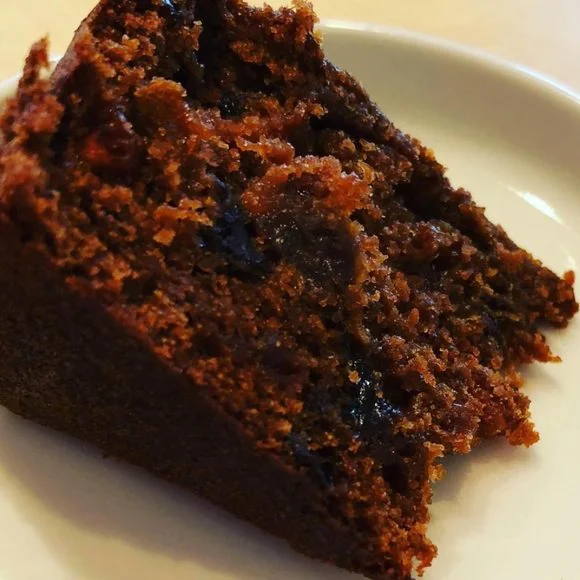
History and Region of Fruit Cake in Antigua and Barbuda
Fruit Cake, a festive and cherished dessert in Antigua and Barbuda, reflects the cultural amalgamation of the Caribbean. With roots in British and African culinary traditions, this rich and flavorful cake has become synonymous with celebrations and special occasions on the islands.
The preparation of Fruit Cake in Antigua and Barbuda is a testament to the region’s love for indulgent, fruit-laden sweets.
Ingredients for Fruit Cake
- 2 cups mixed dried fruits (raisins, currants, sultanas)
- 1 cup candied mixed peel
- 1 cup cherries, halved
- 1 cup chopped nuts (walnuts, almonds)
- 1 cup unsalted butter, softened
- 1 cup brown sugar
- 4 large eggs
- 2 cups all-purpose flour
- 1 teaspoon baking powder
- 1 teaspoon ground cinnamon
- 1/2 teaspoon ground nutmeg
- 1/2 cup molasses
- 1/2 cup rum or brandy
- Zest of one orange
- Zest of one lemon
Fruit Cake Recipe
Prepare Fruits and Nuts
- In a bowl, combine mixed dried fruits, candied mixed peel, halved cherries, and chopped nuts.
- Toss the mixture with a tablespoon of flour to coat the fruits and nuts evenly.
Cream Butter and Sugar
- In a large mixing bowl, cream together softened butter and brown sugar until light and fluffy.
Add Eggs
- Add eggs one at a time, beating well after each addition.
Mix Dry Ingredients
- In a separate bowl, sift together all-purpose flour, baking powder, ground cinnamon, and ground nutmeg.
Combine Wet and Dry Ingredients
- Gradually add the dry ingredients to the butter and sugar mixture, mixing well after each addition.
Incorporate Molasses and Spirits
- Mix in molasses, rum or brandy, orange zest, and lemon zest until well combined.
Fold in Fruits and Nuts
- Gently fold the prepared fruits and nuts into the batter until evenly distributed.
Bake
- Preheat the oven to 325°F (163°C).
- Grease and line a cake pan with parchment paper.
- Pour the batter into the prepared pan and smooth the top.
- Bake for 1.5 to 2 hours or until a toothpick inserted into the center comes out clean.
Cool and Serve
- Allow the Fruit Cake to cool in the pan for 10 minutes before transferring it to a wire rack to cool completely.
- Serve the Fruit Cake in slices for a delightful treat.
Serving Details
- Serves: 10-12 people
- Preparation Time: 30 minutes
- Baking Time: 1.5 to 2 hours
- Calories: (Caloric values can vary based on specific brands and quantities used. It’s advisable to calculate calories based on the precise ingredients and their amounts.)
Antigua Food – Roast Corn

History and Background
Antigua, a picturesque island nestled in the Caribbean, boasts a rich culinary heritage that reflects its diverse cultural influences. One iconic dish that encapsulates the essence of Antiguan cuisine is Roast Corn.
Rooted in the island’s agricultural history and vibrant street food culture, this delectable treat has become a beloved snack enjoyed by locals and visitors alike.
Antigua Food – Roast Corn Ingredients
- Fresh Corn on the Cob: 4 ears
- Butter: 4 tablespoons, melted
- Sea Salt: 1 teaspoon
- Ground Black Pepper: 1/2 teaspoon
- Lime Wedges: for serving
Antigua Food – Roast Corn Recipe
1. Preparation of Ingredients
- Peel back the husks of the corn, leaving them attached to the base.
- Remove the silk from the corn and pull the husks back up to cover the corn.
2. Soaking the Corn
- Submerge the corn in a large bowl of cold water and let it soak for 10-15 minutes.
3. Preheating the Grill
- Preheat the grill to medium-high heat.
4. Grilling the Corn
- Shake off excess water from the corn.
- Place the corn on the preheated grill and cook for 15-20 minutes, turning occasionally, until the husks are charred and the corn is tender.
5. Seasoning
- Brush the grilled corn with melted butter.
- Sprinkle sea salt and ground black pepper evenly over the corn.
6. Serving
- Serve the Roast Corn hot, accompanied by lime wedges for a burst of citrusy flavor.
Serving Information
- Servings: 4 people
- Cooking Time: 30 minutes (including soaking time)
- Calories: Approximately 200 calories per serving
Enjoy this Antiguan delight, where the smoky aroma of roasted corn meets the savory goodness of butter and spices, creating a sensory journey through the island’s culinary history.
Antigua Food – Black Pudding

History and Background
Originating from the Caribbean jewel of Antigua, Black Pudding is a culinary treasure deeply rooted in the island’s African and British influences. This dish reflects the fusion of diverse cultural elements, showcasing the resilience and creativity of the Antiguan people.
Traditionally enjoyed as a hearty breakfast or a flavorful addition to festive occasions, Black Pudding embodies the spirit of Antiguan gastronomy.
Ingredients
- Blood Sausage (Black Pudding): 1 lb
- Onions: 2 medium, finely chopped
- Garlic Cloves: 3, minced
- Thyme: 1 teaspoon, dried
- Allspice: 1/2 teaspoon, ground
- Scallions: 4, finely chopped
- Salt: 1 teaspoon
- Black Pepper: 1/2 teaspoon
- Vegetable Oil: 2 tablespoons
Recipe
1. Preparation of Ingredients
- Finely chop the onions.
- Mince the garlic cloves.
- Finely chop the scallions.
2. Cooking the Black Pudding Mixture
- In a large skillet, heat vegetable oil over medium heat.
- Add chopped onions, minced garlic, and scallions. Sauté until the onions are translucent.
3. Preparing the Blood Sausage
- Remove the casing from the blood sausage and crumble the sausage into the skillet with sautéed vegetables.
4. Seasoning
- Add thyme, ground allspice, salt, and black pepper to the mixture. Stir well to combine.
5. Cooking the Black Pudding
- Cook the mixture over medium heat for 15-20 minutes, stirring occasionally, until the black pudding is cooked through and browned.
6. Serving
- Serve the Black Pudding hot, either on its own or with traditional sides like fried dumplings or breadfruit.
Serving Information
- Servings: 4 people
- Cooking Time: 30 minutes
- Calories: Approximately 300 calories per serving
Indulge in the savory flavors of Antigua with Black Pudding, a dish that encapsulates the island’s culinary diversity and cultural heritage.
Antigua Food – Fried dumplings

History and Background
Fried dumplings, a staple in Antiguan cuisine, represent the intersection of African, British, and indigenous culinary influences on the island. Serving as a versatile side dish or a standalone snack, these dumplings embody the simplicity and deliciousness that characterize Antiguan comfort food.
The history of fried dumplings in Antigua is a testament to the island’s diverse cultural tapestry and its ability to create culinary delights from humble ingredients.
Ingredients
- All-Purpose Flour: 2 cups
- Baking Powder: 1 tablespoon
- Salt: 1/2 teaspoon
- Sugar: 1 tablespoon
- Water: 3/4 cup (or as needed for dough consistency)
- Vegetable Oil: For frying
Recipe
1. Preparing the Dough
- In a large mixing bowl, combine the all-purpose flour, baking powder, salt, and sugar.
- Gradually add water, stirring continuously, until a soft, slightly sticky dough forms.
2. Kneading the Dough
- Turn the dough onto a floured surface and knead for 3-5 minutes until it becomes smooth and elastic.
3. Shaping the Dumplings
- Pinch off small portions of the dough and roll them into balls or shape them into small rounds.
4. Heating the Oil
- In a deep skillet or frying pan, heat vegetable oil over medium-high heat until it reaches 350°F (175°C).
5. Frying the Dumplings
- Carefully place the shaped dumplings into the hot oil, ensuring not to overcrowd the pan.
- Fry each side for 2-3 minutes or until golden brown, using a slotted spoon to turn them.
6. Draining and Serving
- Transfer the fried dumplings to a paper towel-lined plate to drain excess oil.
- Serve the dumplings warm, either as a delightful side dish or a standalone treat.
Serving Information
- Servings: 4 people
- Cooking Time: 20 minutes
- Calories: Approximately 150 calories per serving
Enjoy the crispy exterior and soft, doughy interior of Antiguan Fried Dumplings, a culinary delight that encapsulates the island’s warm and comforting food culture.
Conclusion
Antiguan cuisine offers a delectable journey through the vibrant flavors, rich history, and diverse cultural influences of this Caribbean gem. From savory seafood dishes to tropical fruit delicacies, Antiguan food is a celebration of the island’s bountiful harvests and culinary traditions passed down through generations.
Through our exploration of Antiguan cuisine, we’ve discovered not just meals but a reflection of the island’s vibrant spirit—a spirit of warmth, hospitality, and a deep connection to the land and sea. Whether savoring a hearty plate of pepperpot, indulging in freshly caught lobster, or enjoying a refreshing glass of rum punch, every bite tells a story of tradition, community, and the island’s unique identity.
As we bid farewell to the tantalizing aromas and mouthwatering flavors of Antiguan food, let us carry with us the memories of shared meals and joyful gatherings with loved ones. And may we continue to embrace the culinary treasures of Antigua, keeping alive the traditions and legacies that make its food a true delight for the senses.
Frequently Asked Questions
What are the signature dishes that showcase the unique flavors of Antigua?
Antigua boasts a rich culinary heritage, and its signature dishes reflect a harmonious blend of African, European, and indigenous Caribbean influences. One standout is “Fungee and Pepperpot,” a hearty dish featuring cornmeal dumplings (fungee) served with a flavorful okra-based stew (pepperpot).
This dish perfectly encapsulates the island’s cultural diversity and the creative use of local ingredients.
How does the abundance of fresh seafood contribute to Antigua’s vibrant food scene?
Antigua’s coastal location provides an abundance of fresh seafood, a cornerstone of its vibrant food scene. Grilled lobster, conch salad, and saltfish are just a few examples of dishes that highlight the island’s reliance on the bounties of the sea.
The culinary community’s commitment to sustainable fishing practices ensures that each seafood dish not only tantalizes the taste buds but also reflects a commitment to preserving the marine ecosystem.
What role do spices play in defining the bold flavors of Antiguan cuisine?
Spices play a pivotal role in Antiguan cuisine, infusing dishes with bold and distinctive flavors. The island’s spice markets are a sensory delight, offering a range of aromatic spices like cinnamon, nutmeg, and allspice.
Whether it’s the jerk seasoning on grilled meats or the spicy kick in pepper sauces, Antigua’s inventive use of spices elevates its culinary offerings, creating a taste experience that lingers in the memory.
How do local food festivals contribute to preserving Antigua’s culinary traditions?
Antigua’s vibrant food festivals, such as the Antigua and Barbuda Food and Drink Festival, serve as vital platforms for preserving and celebrating the island’s culinary traditions.
These events showcase a diverse array of local dishes, provide a stage for talented chefs, and offer a unique opportunity for locals and visitors alike to immerse themselves in Antigua’s rich food culture.
Can you highlight the role of “Bush Tea” in Antigua’s traditional beverage culture?
“Bush Tea,” a traditional herbal infusion, holds a special place in Antigua’s beverage culture. Made from locally sourced herbs and plants, this caffeine-free beverage is renowned for its medicinal properties and refreshing taste.
Islanders often share stories of the therapeutic benefits of different bush teas, creating a cultural connection between the beverage and the well-being of the community.
How have food markets like the St. John’s Farmers’ Market become hubs for culinary exploration?
Food markets, such as the St. John’s Farmers’ Market, have evolved into culinary hubs, offering a diverse array of locally grown produce, artisanal products, and ready-to-eat delights.
These markets provide a space for farmers, chefs, and food enthusiasts to come together, fostering a sense of community and promoting sustainable, farm-to-table practices that enhance the overall quality and authenticity of Antiguan cuisine.
In what ways does Antigua’s culinary scene embrace innovation while staying rooted in tradition?
Antigua’s culinary scene strikes a delicate balance between innovation and tradition. While chefs experiment with modern techniques and global flavors, they remain deeply connected to local ingredients and traditional cooking methods. The result is a dynamic culinary landscape that preserves the essence of Antiguan food while embracing the ever-evolving world of gastronomy.

